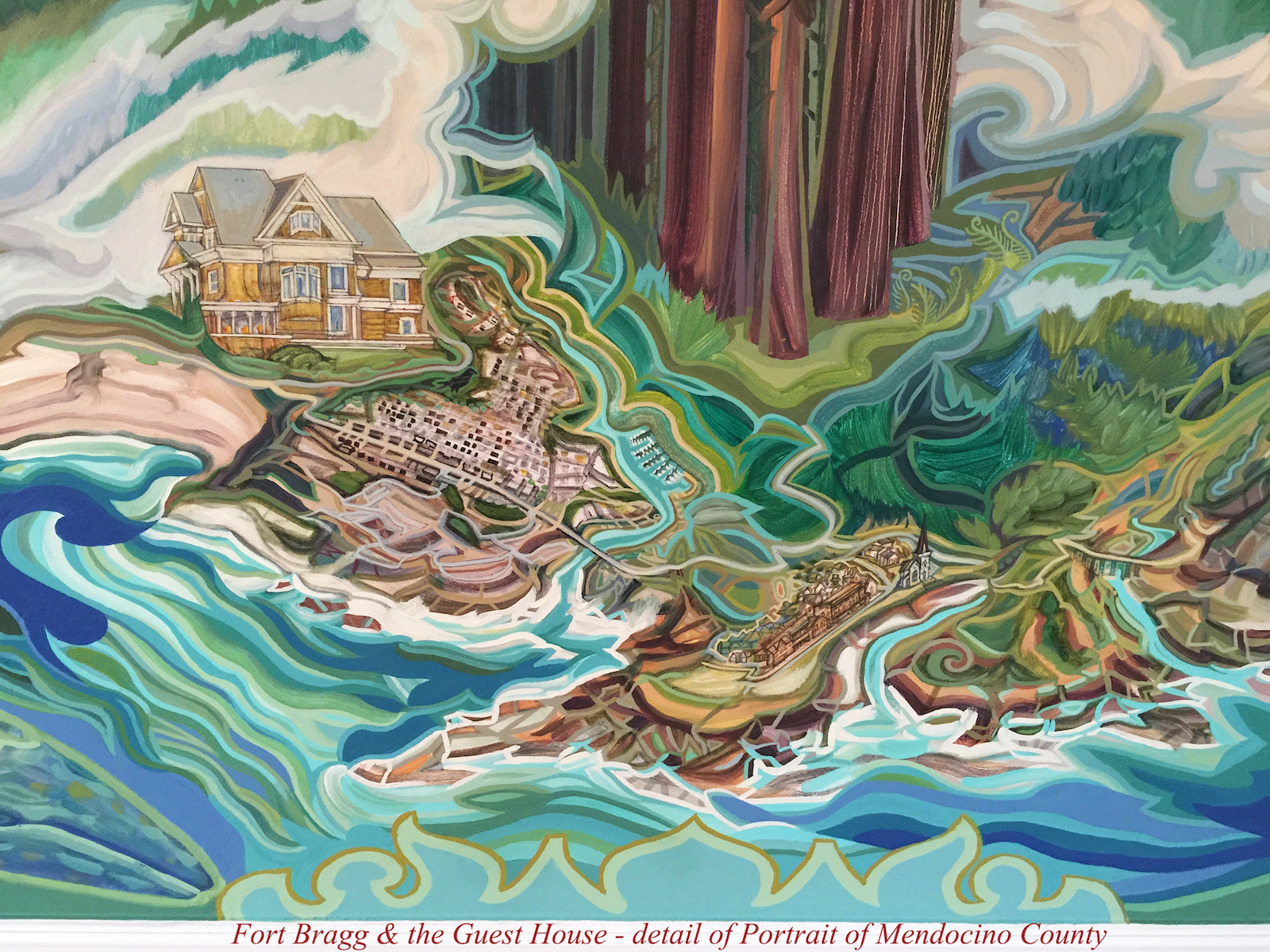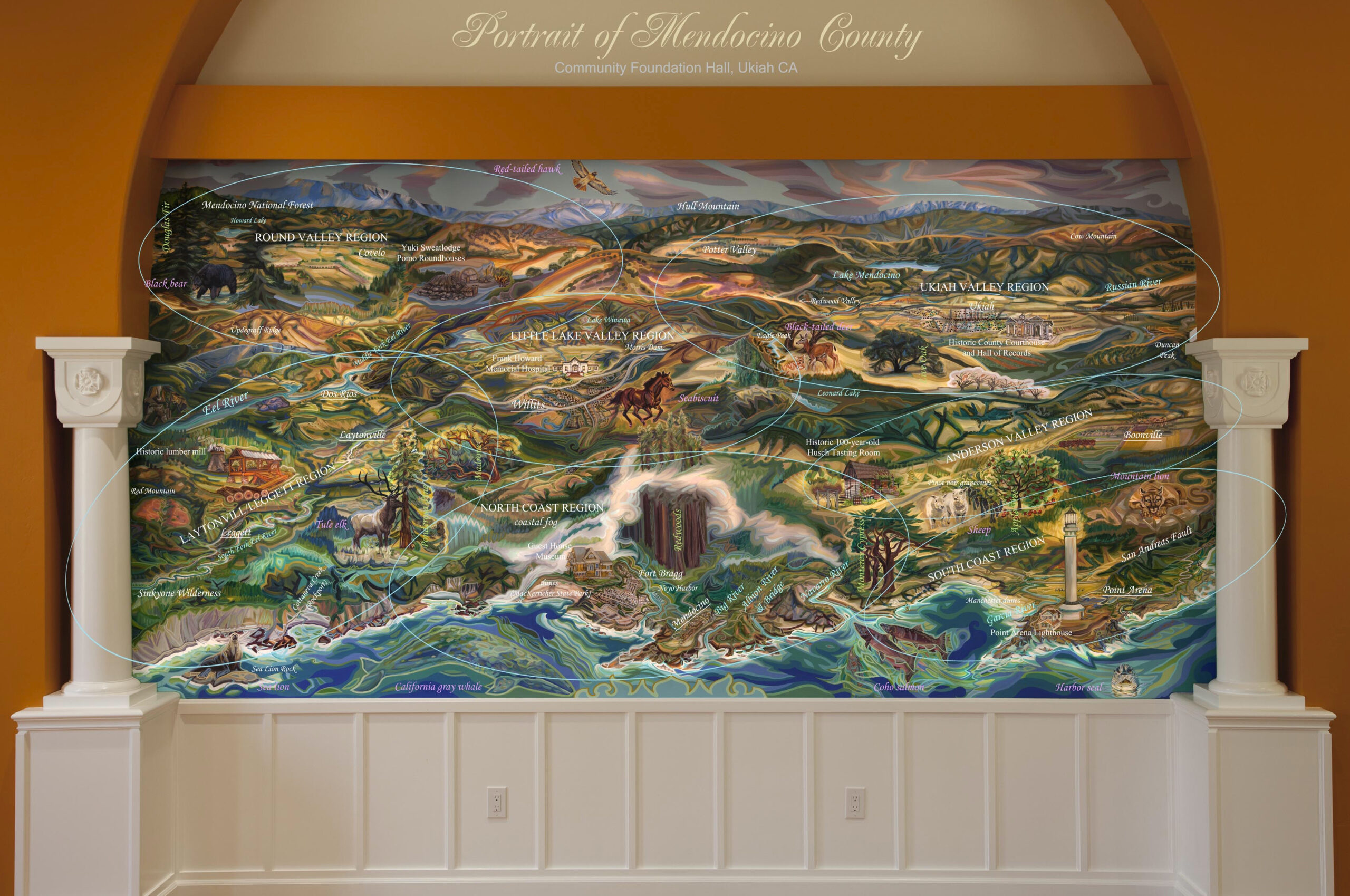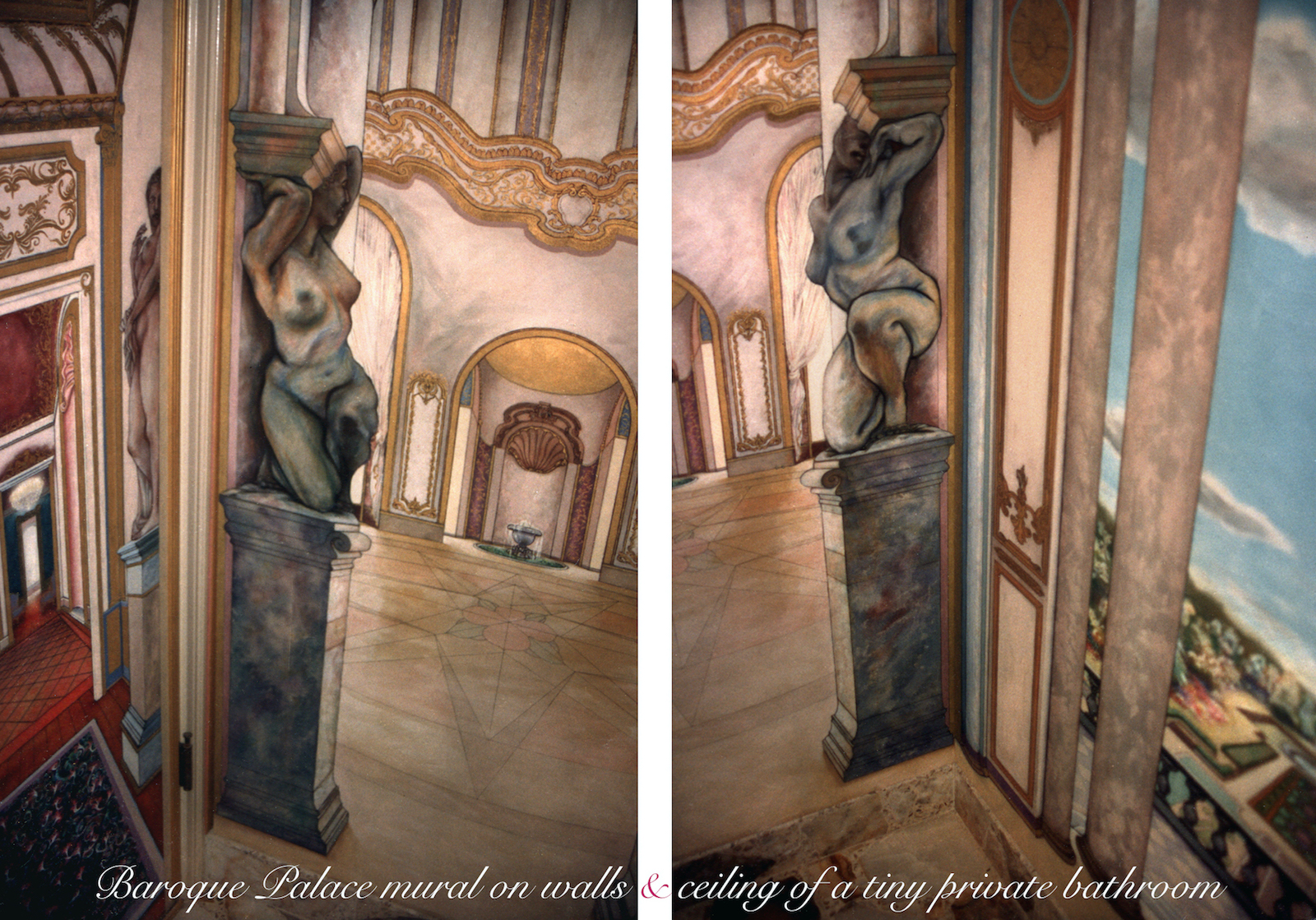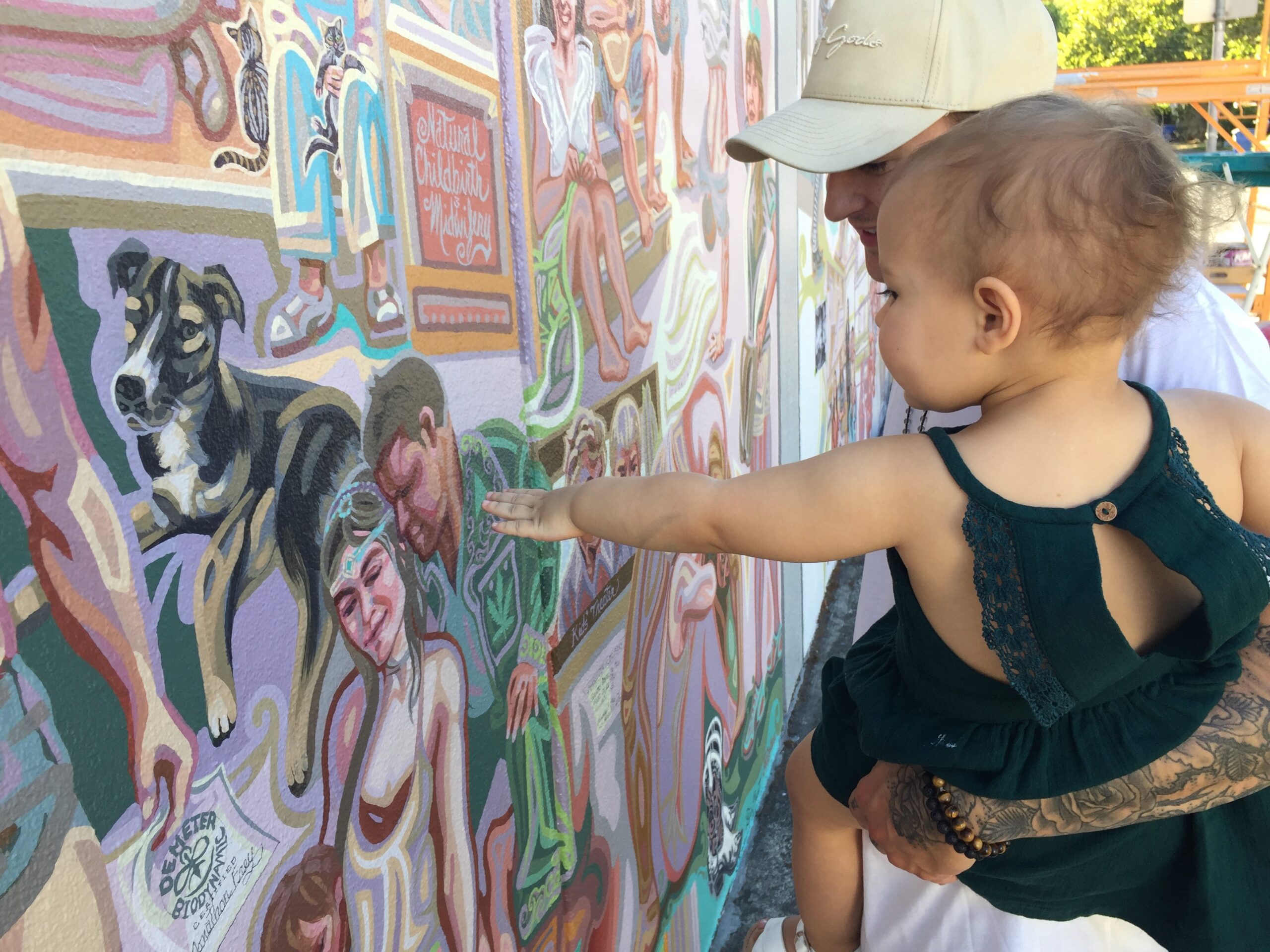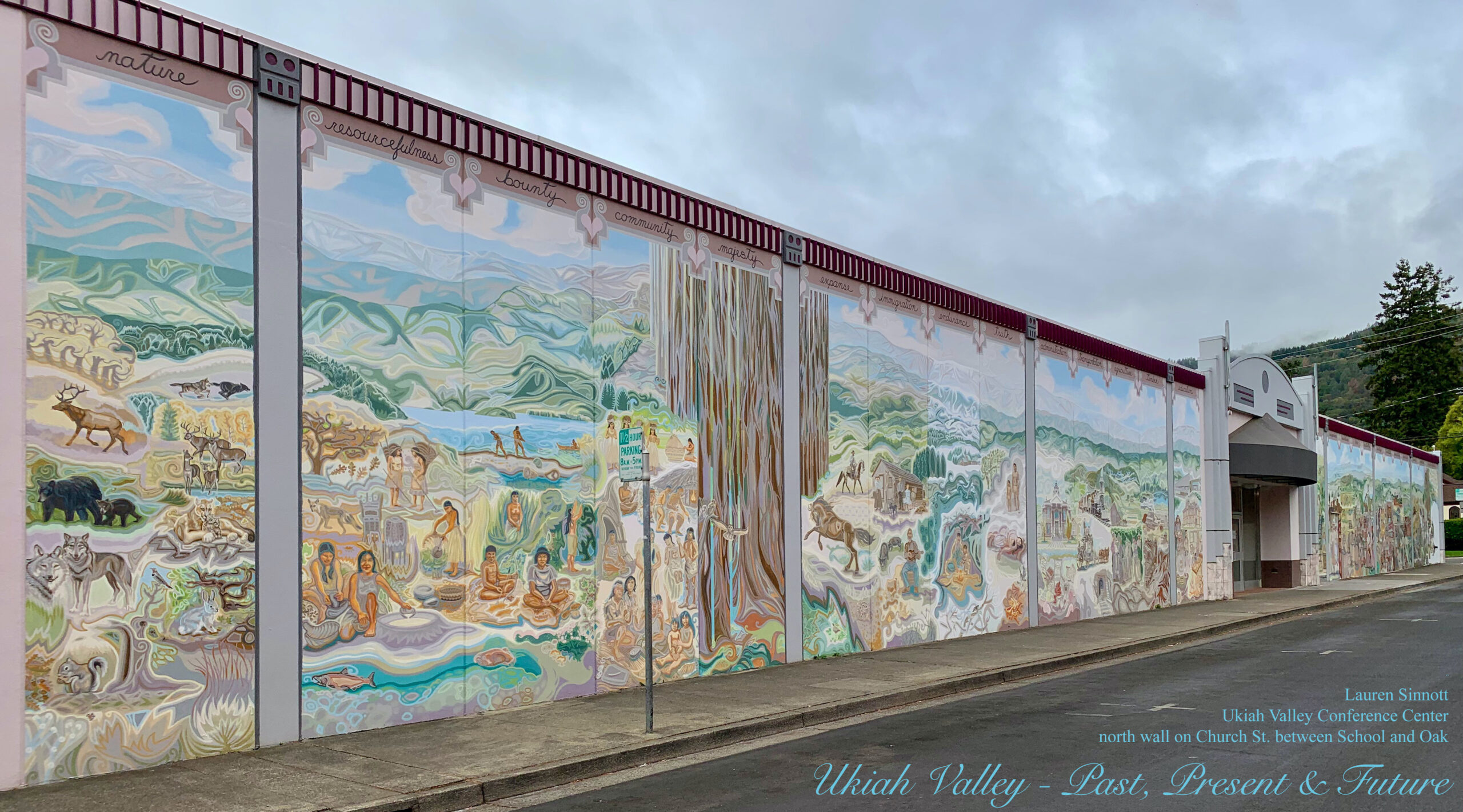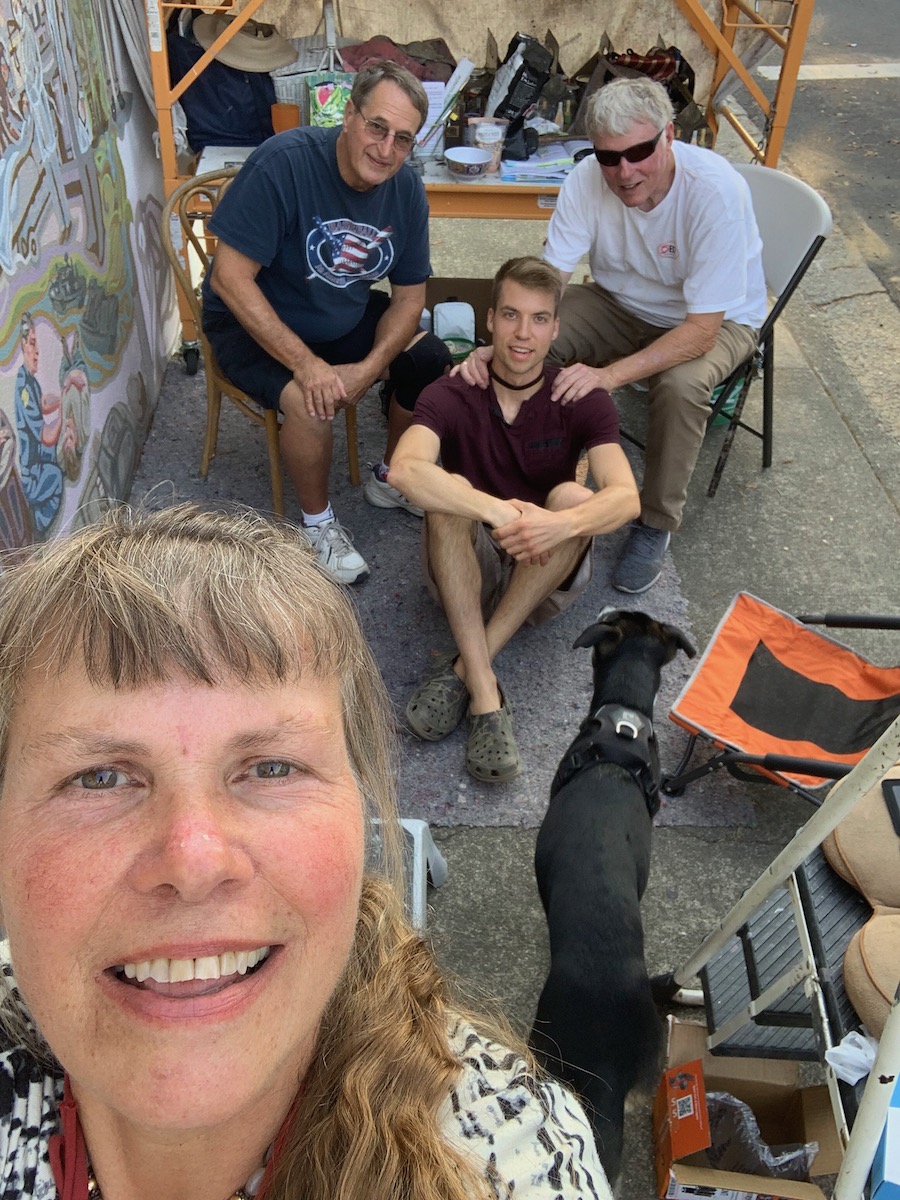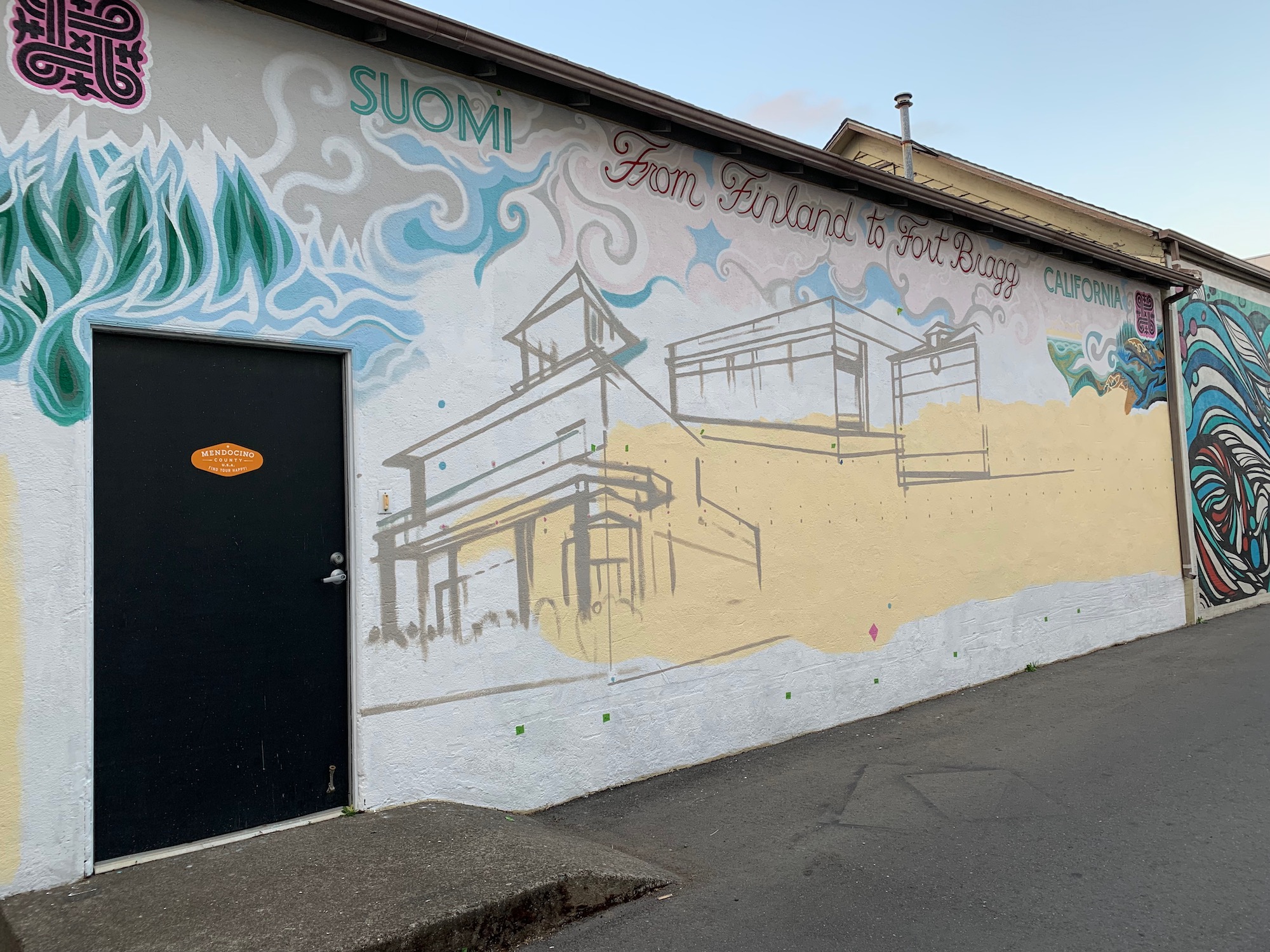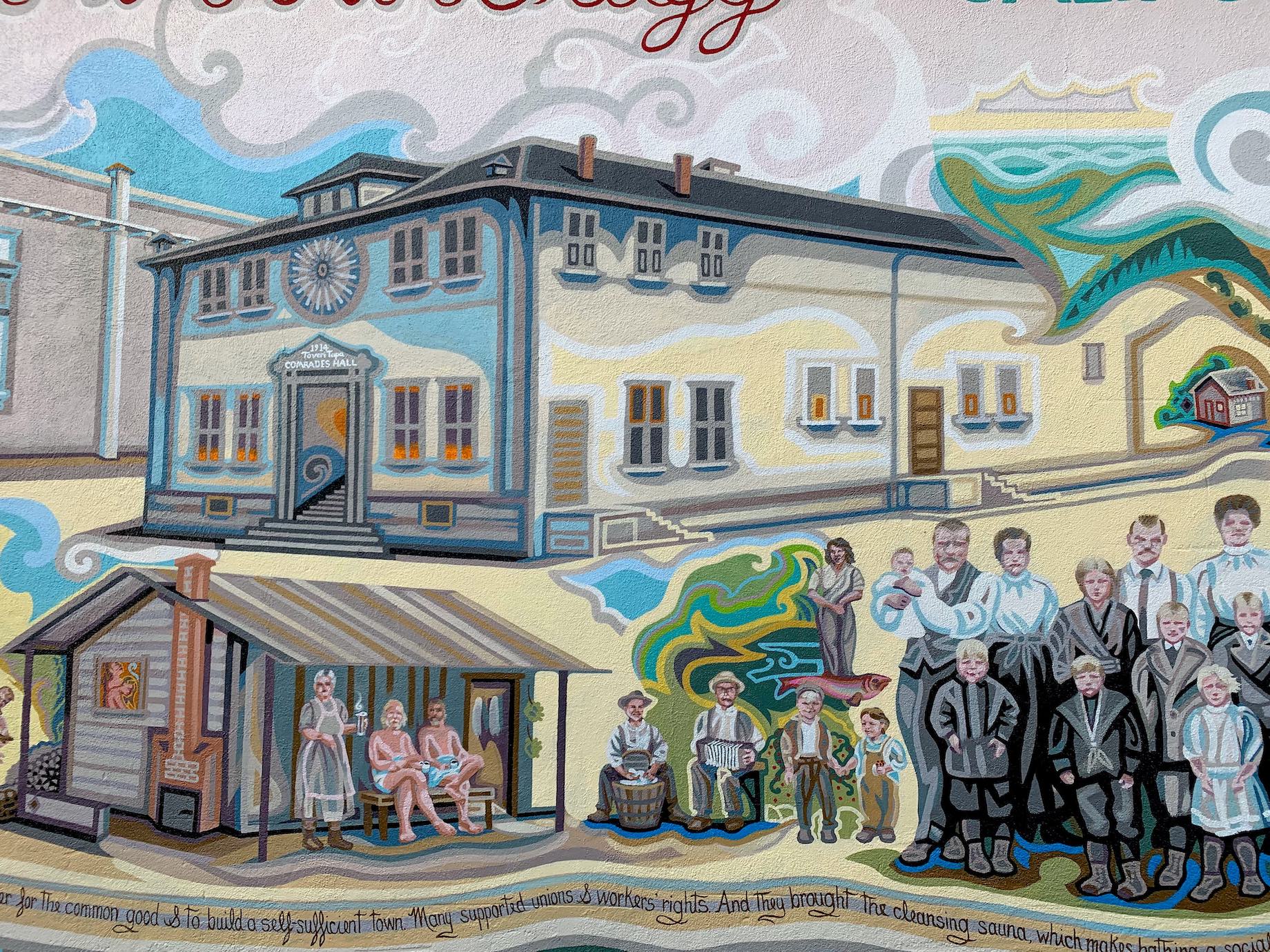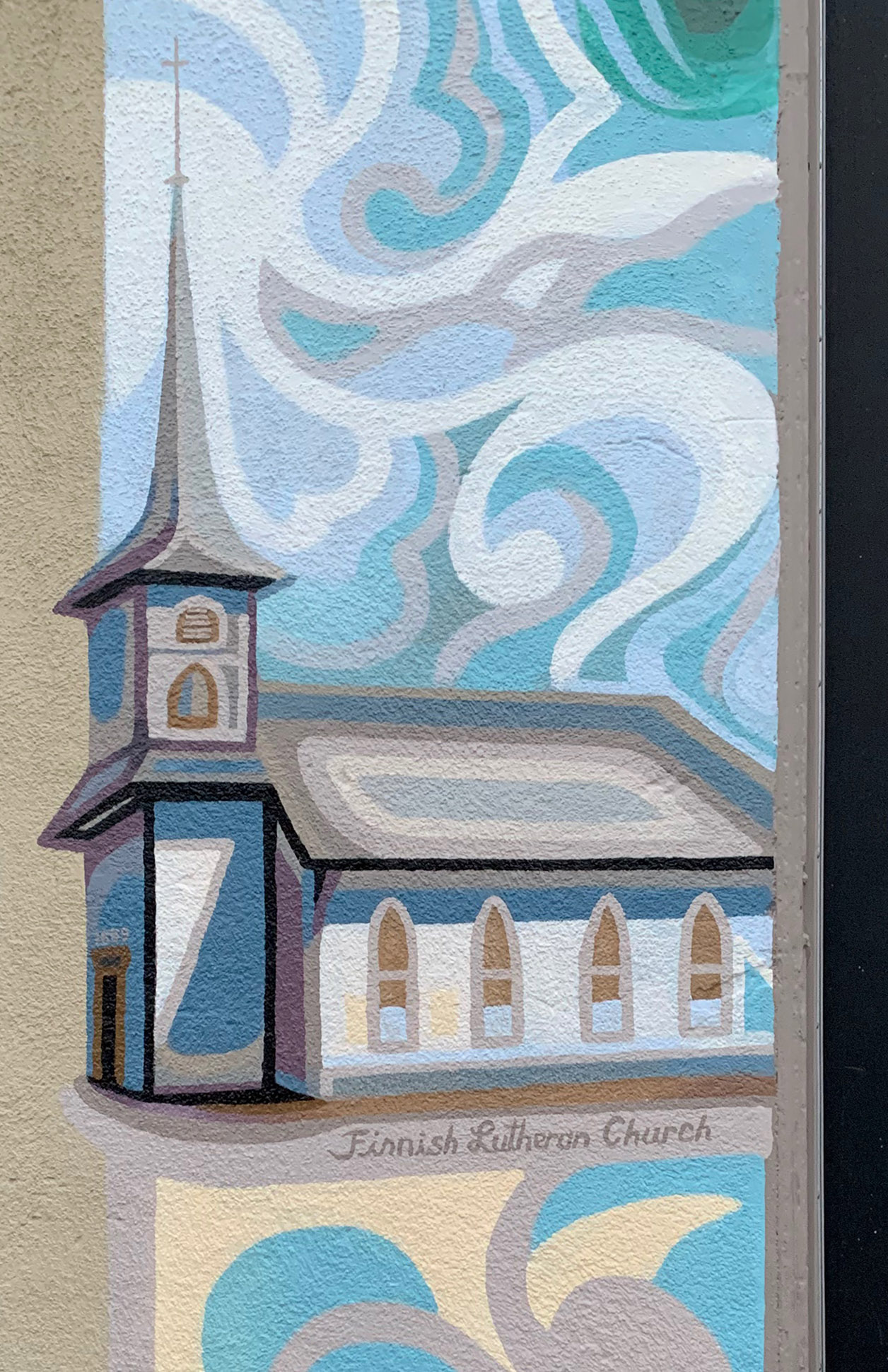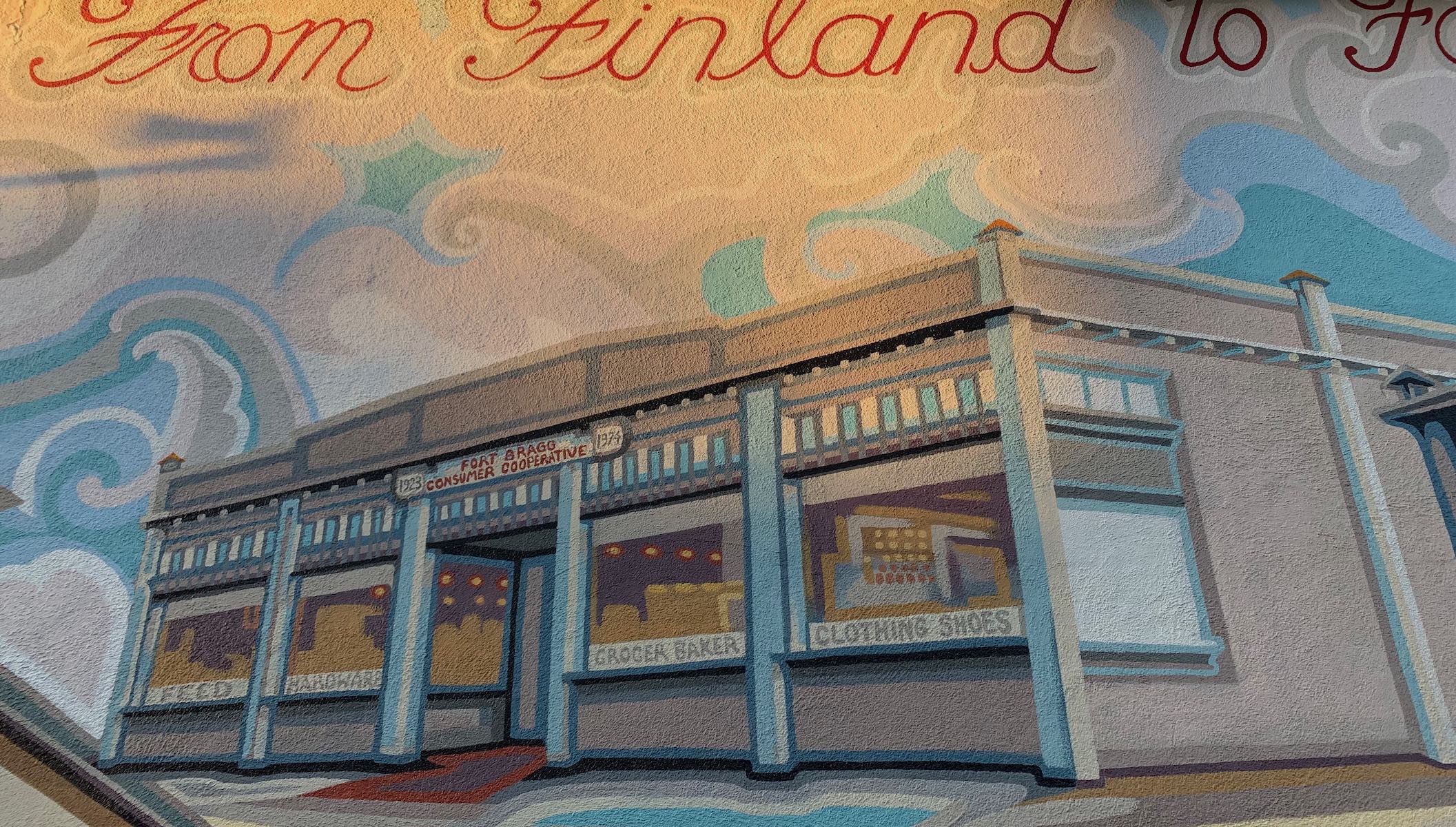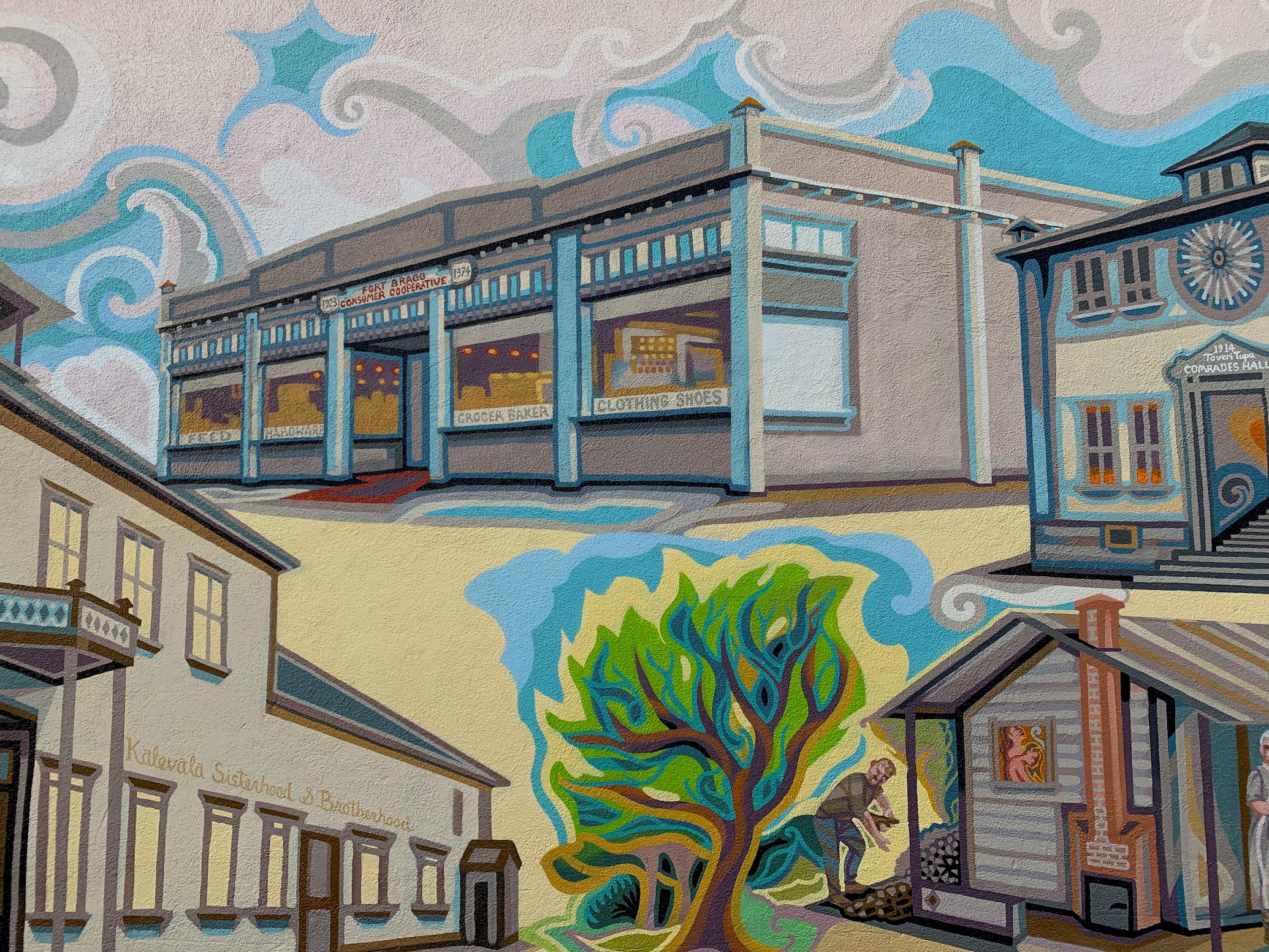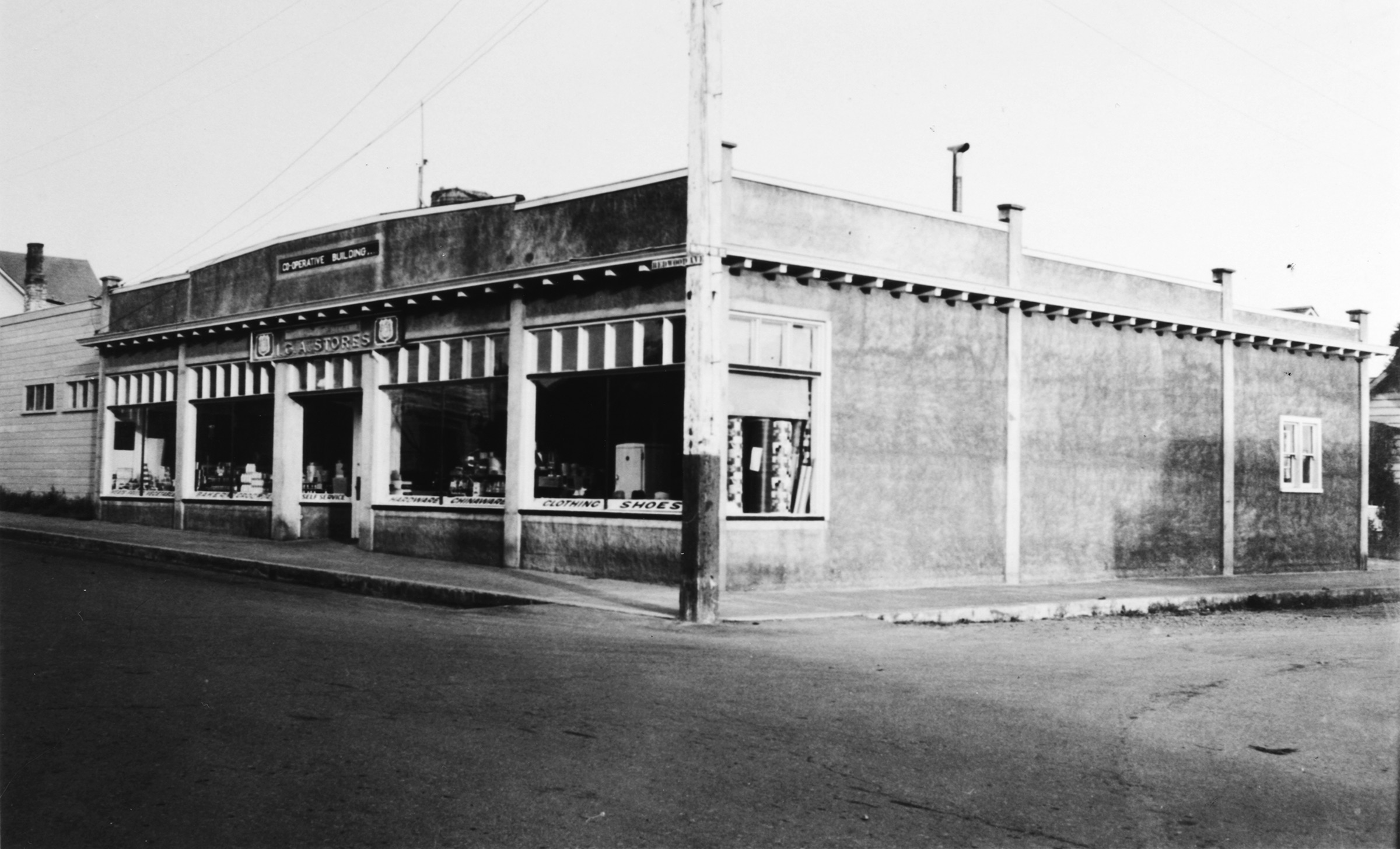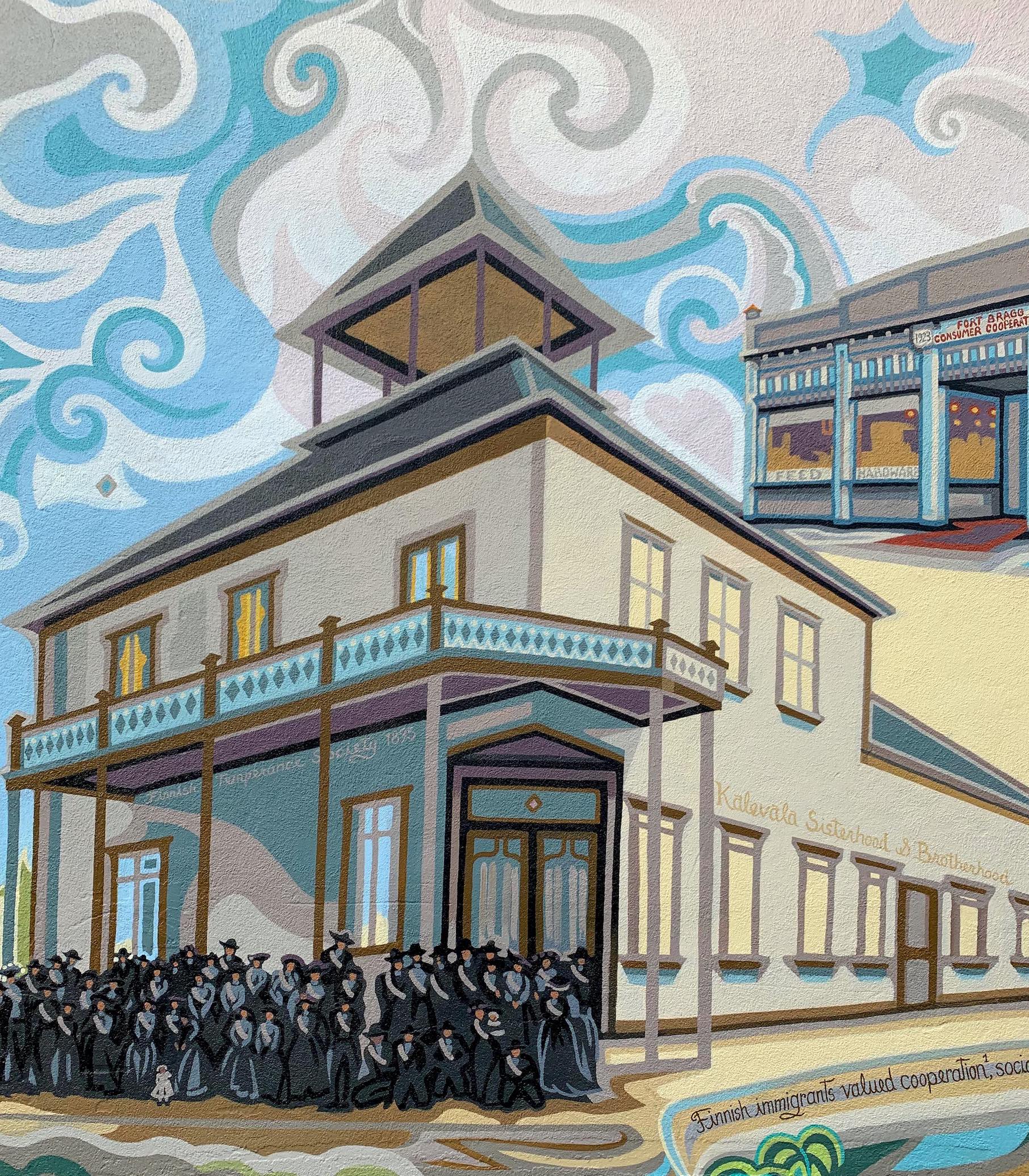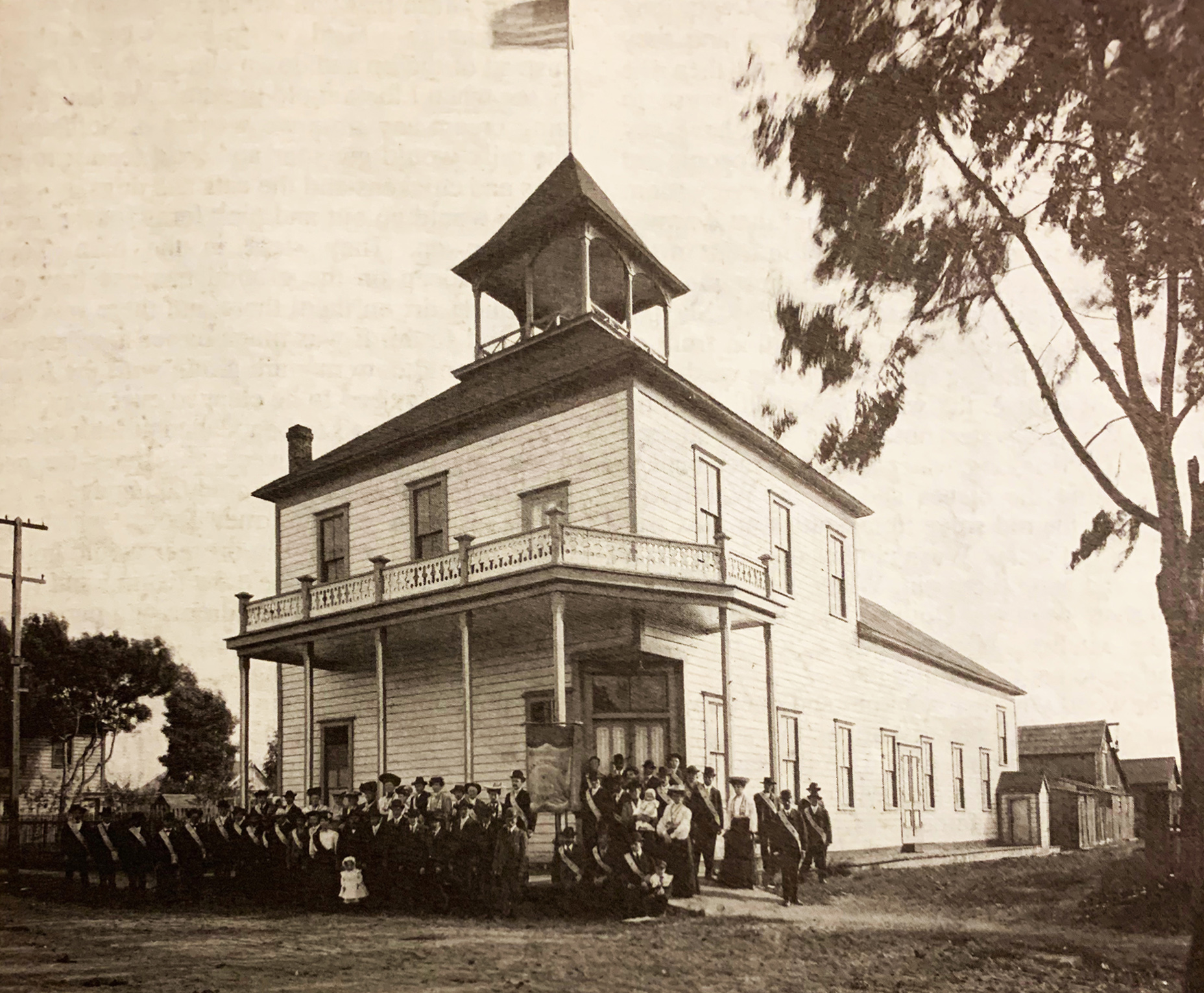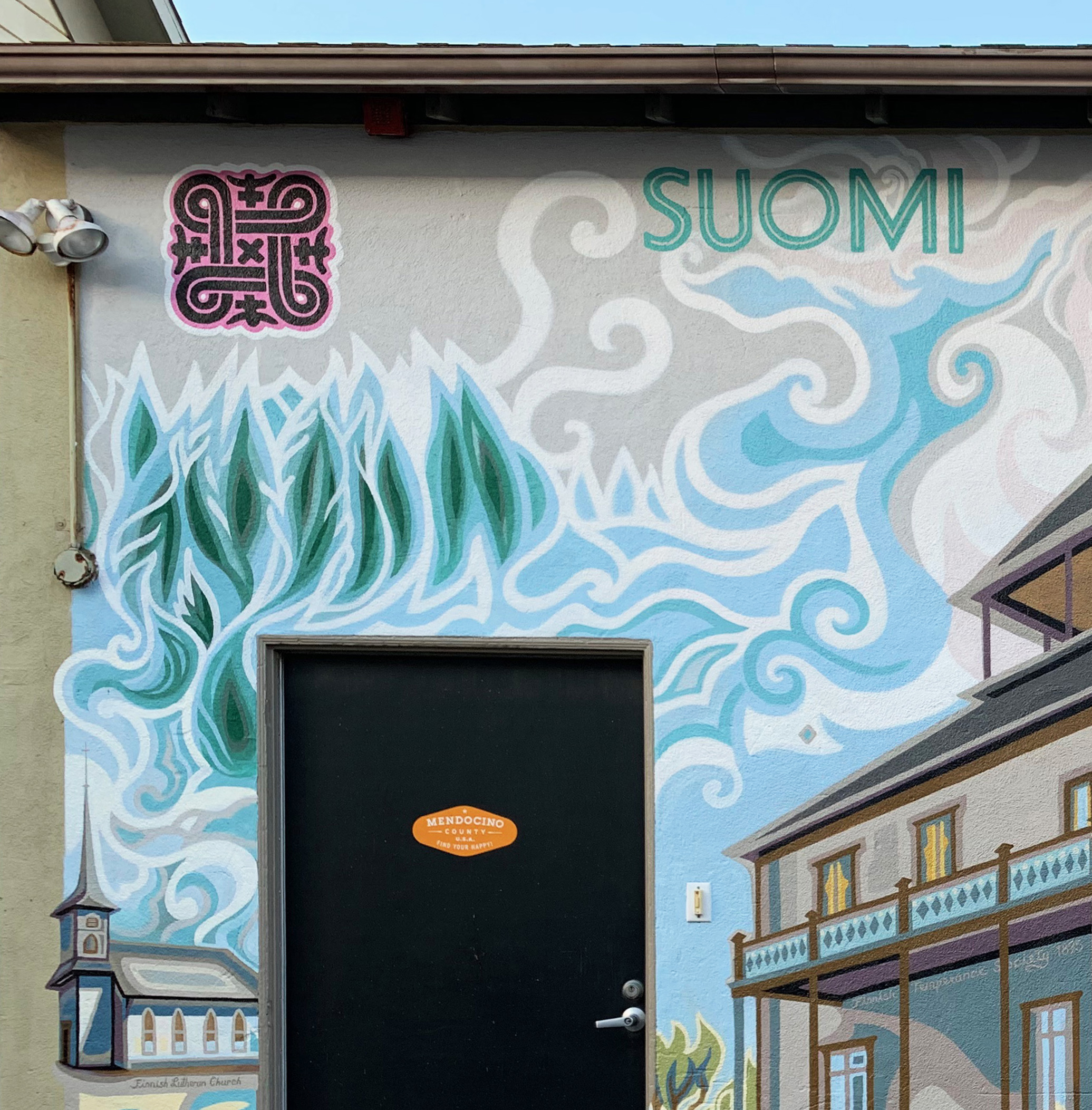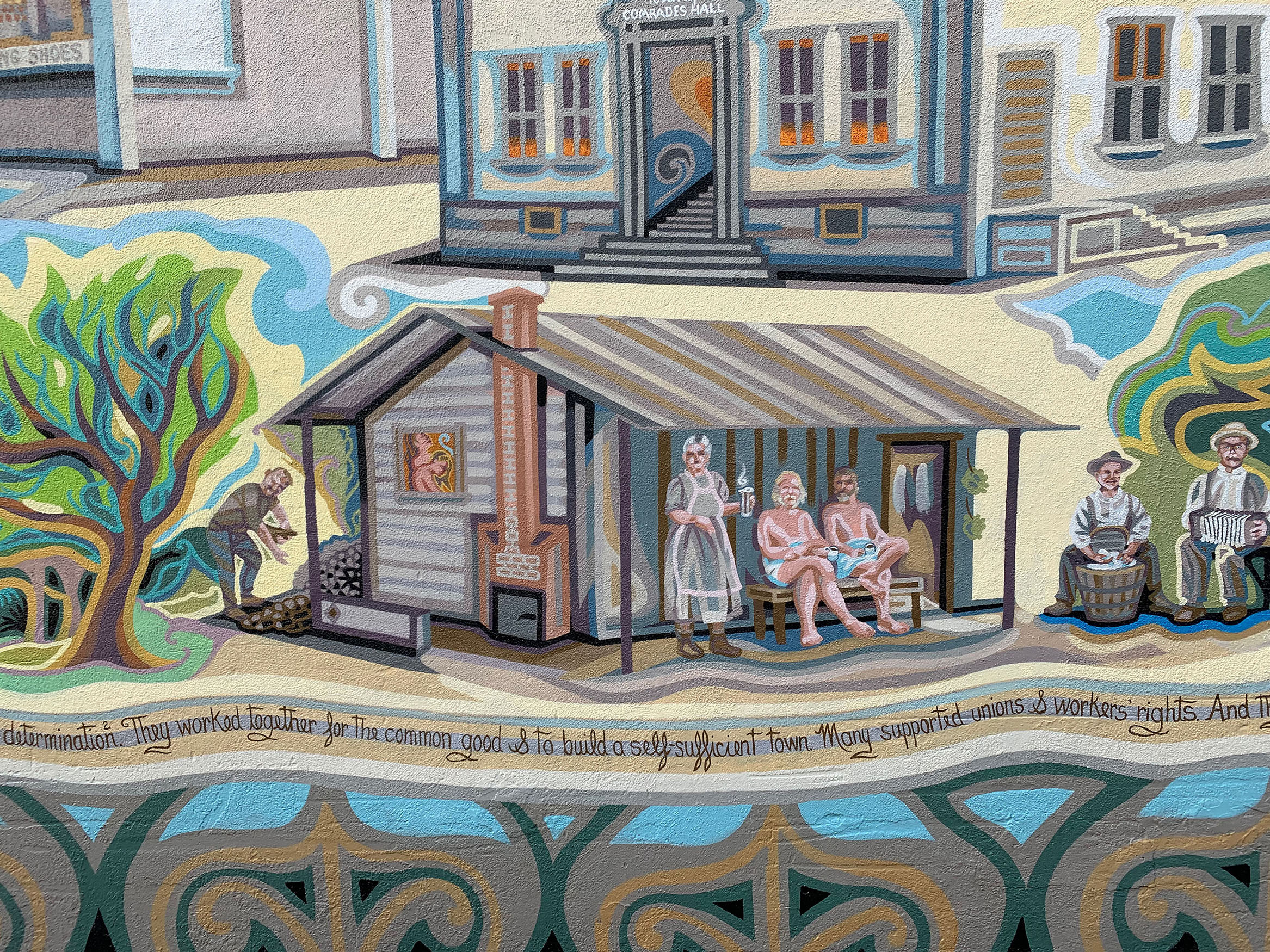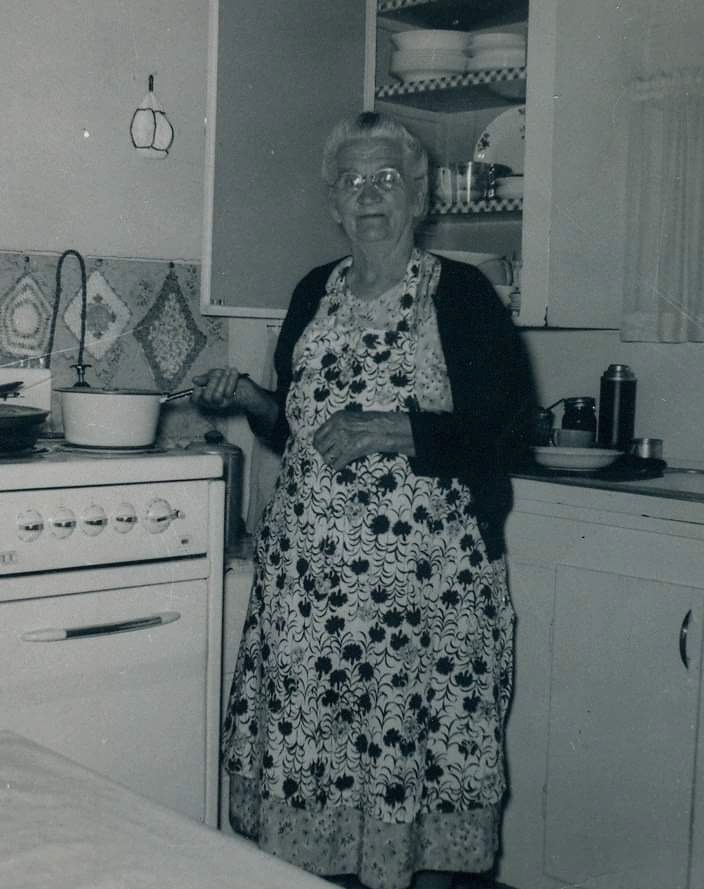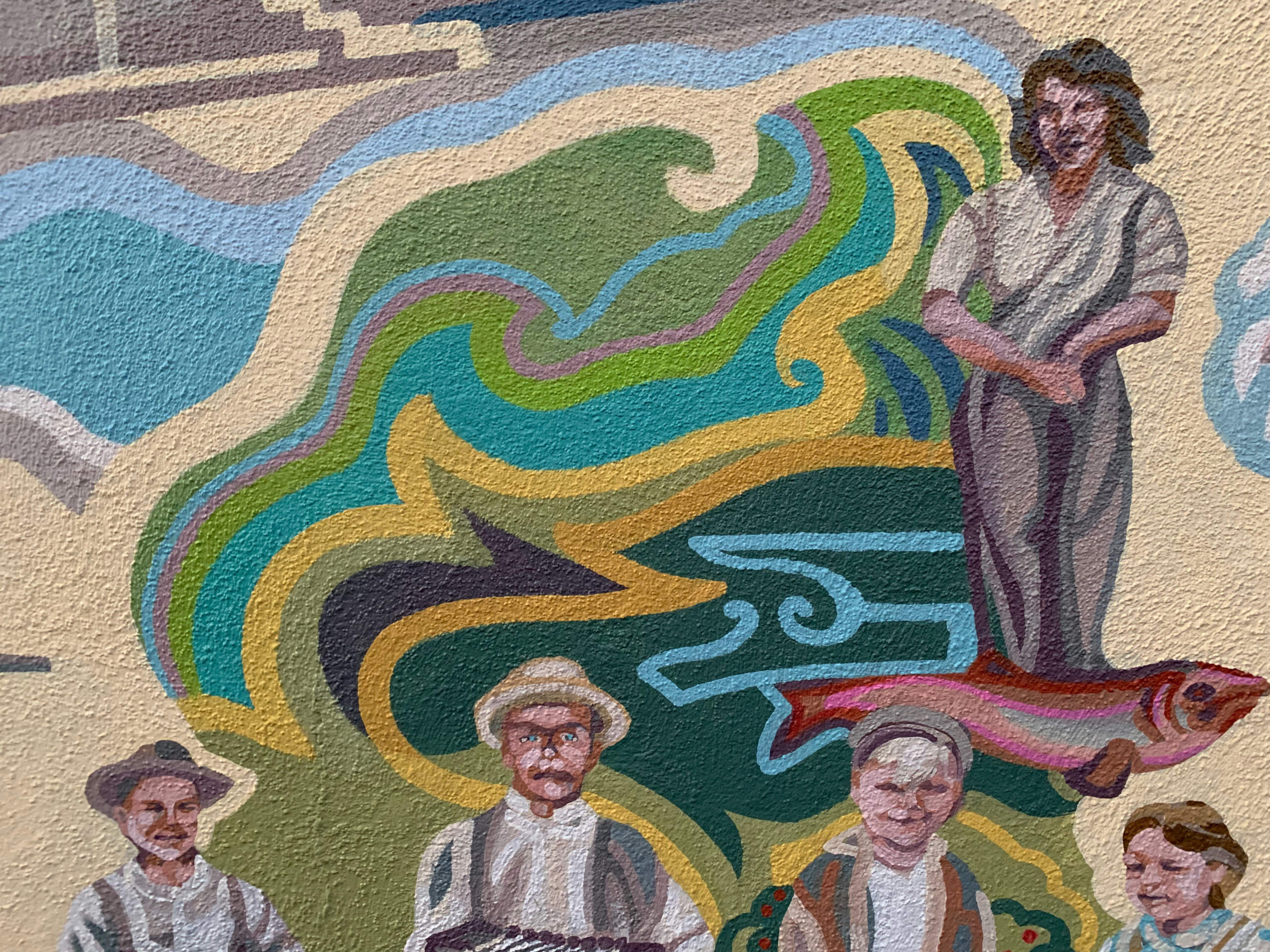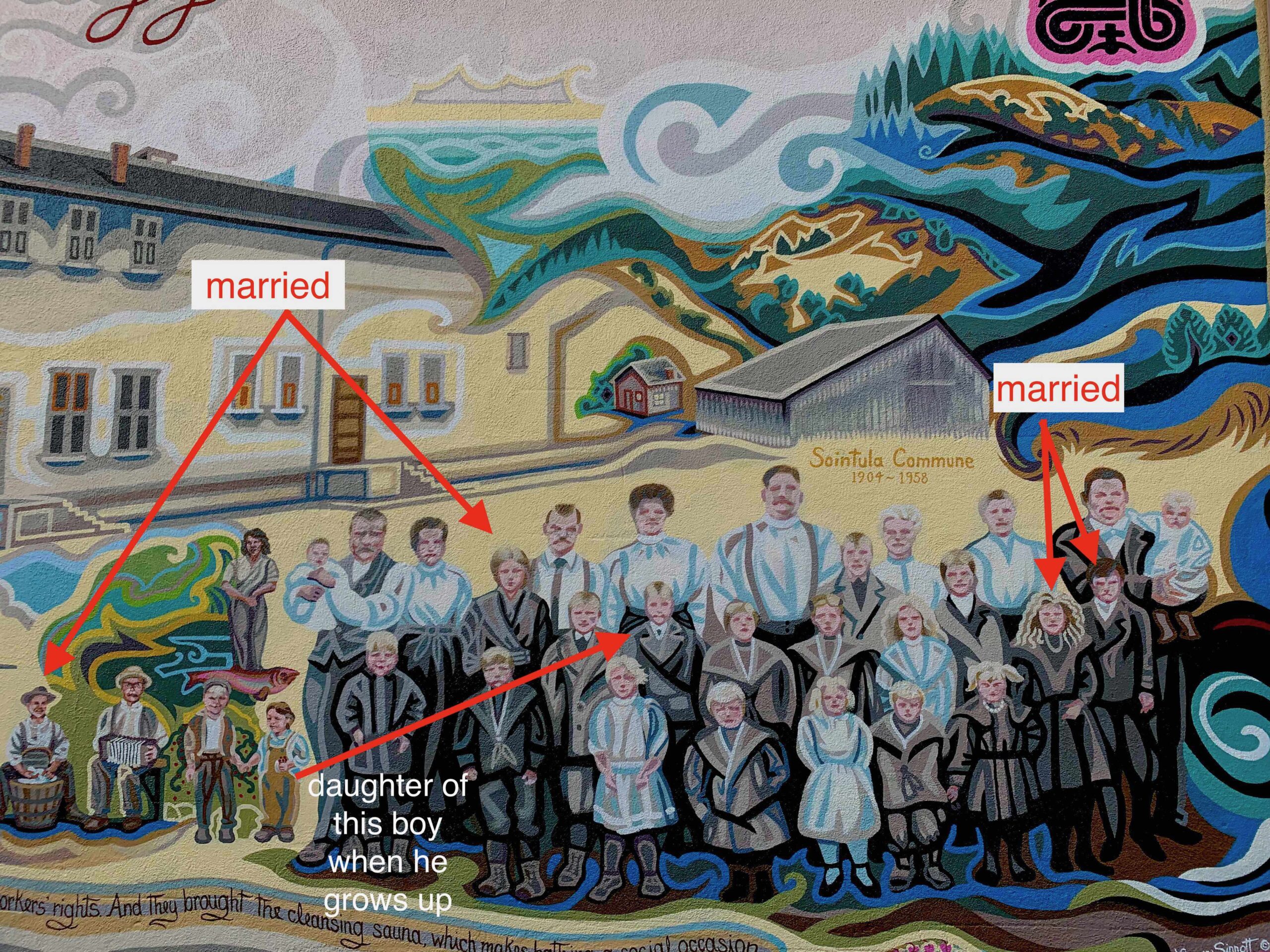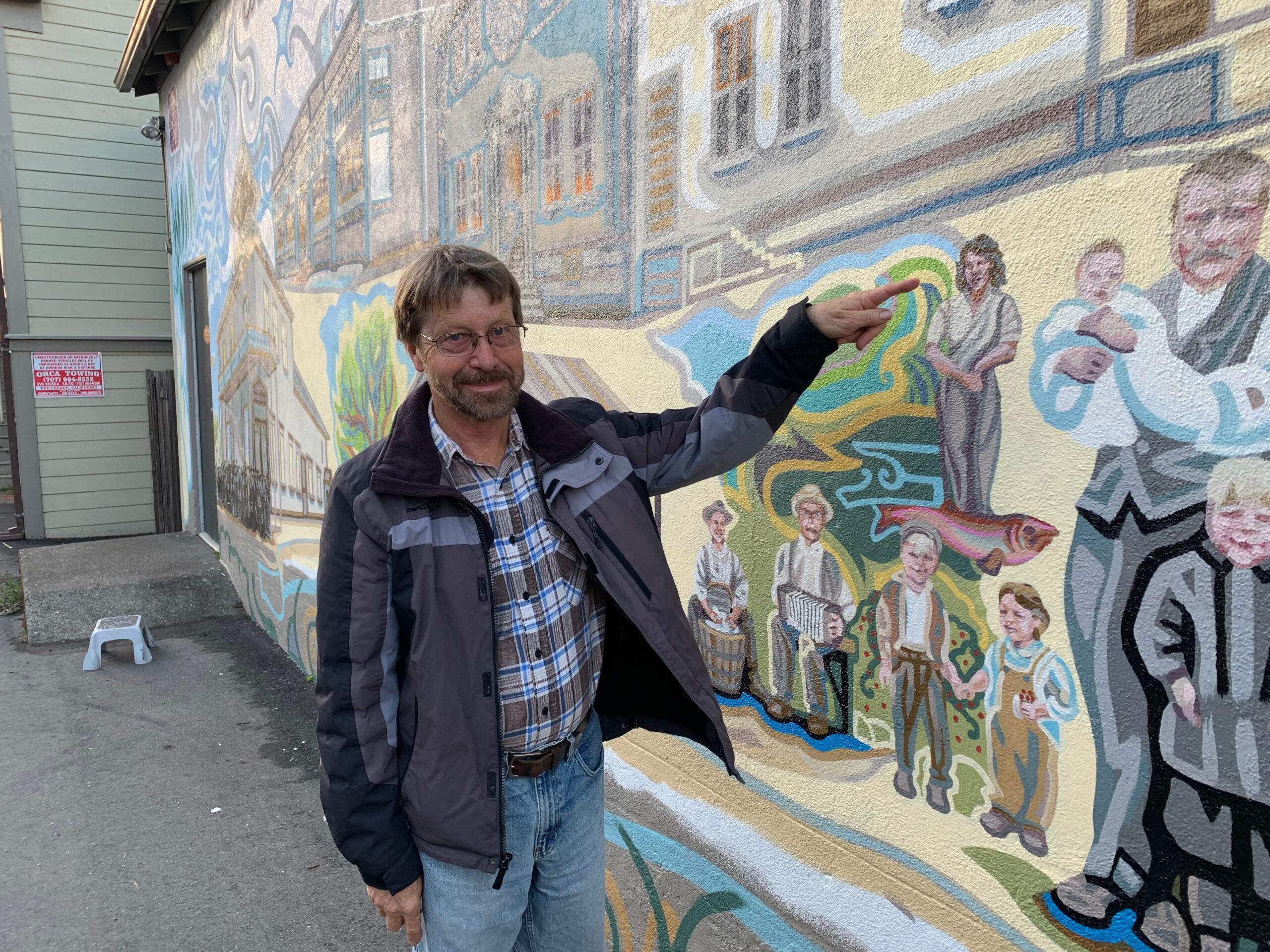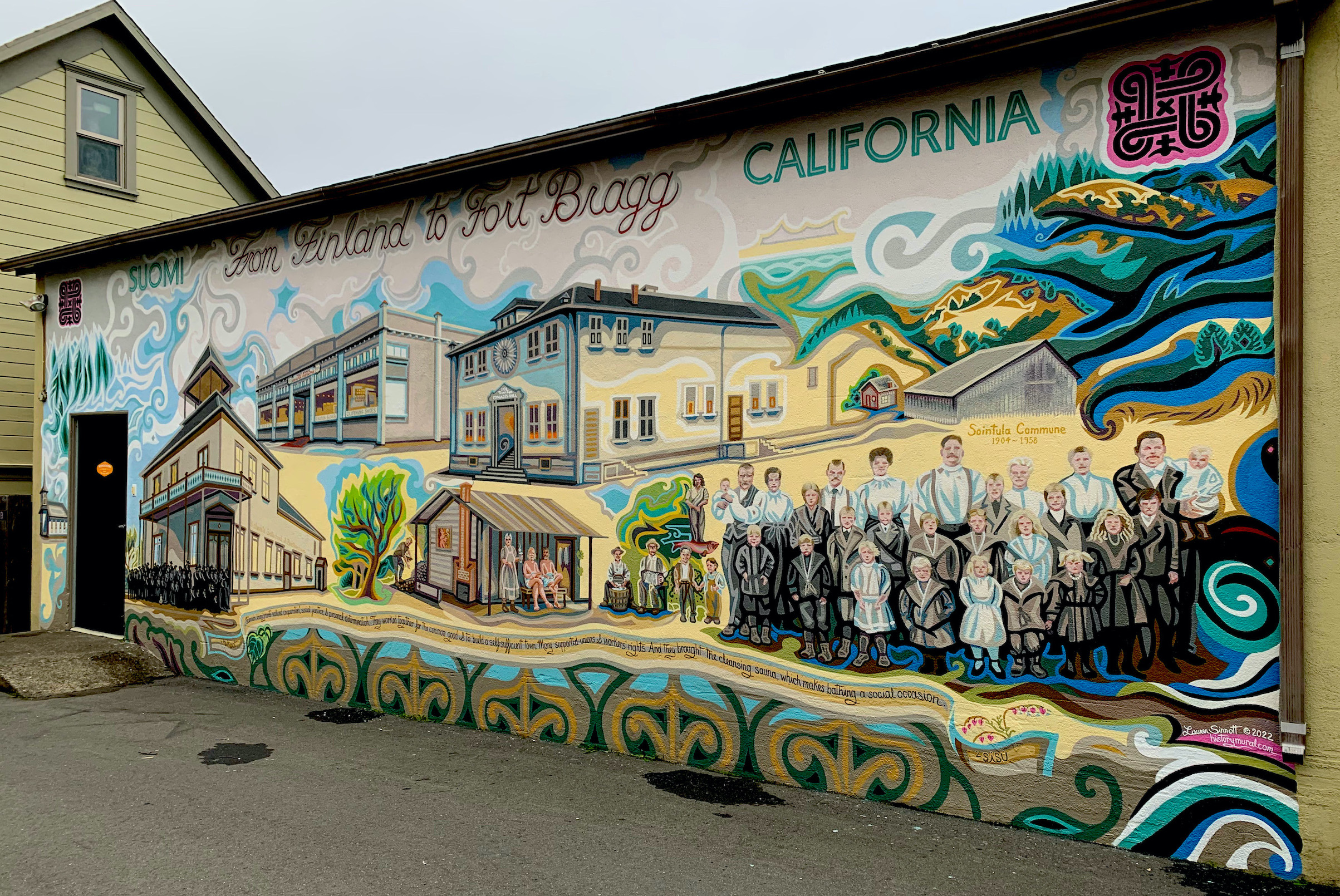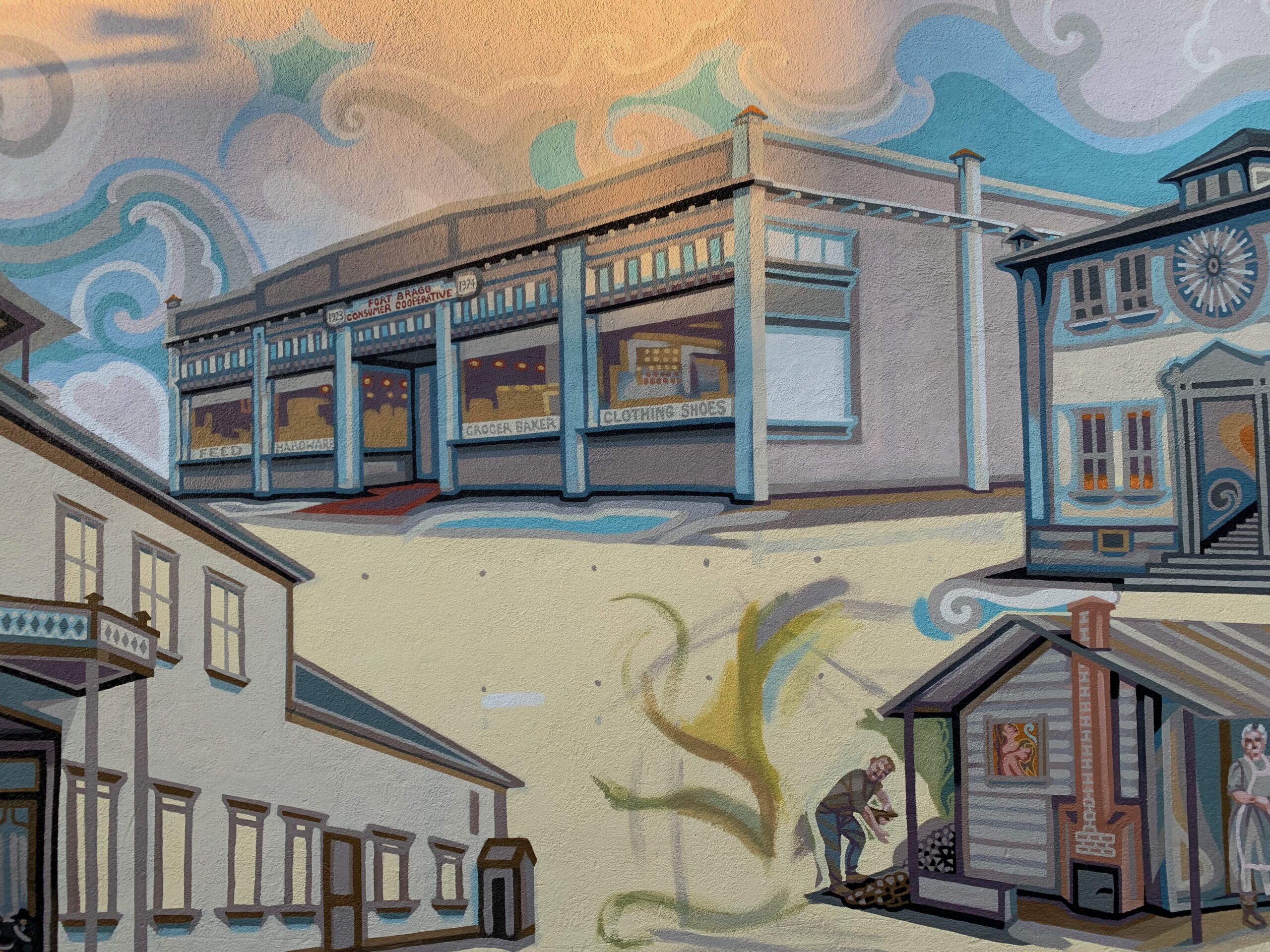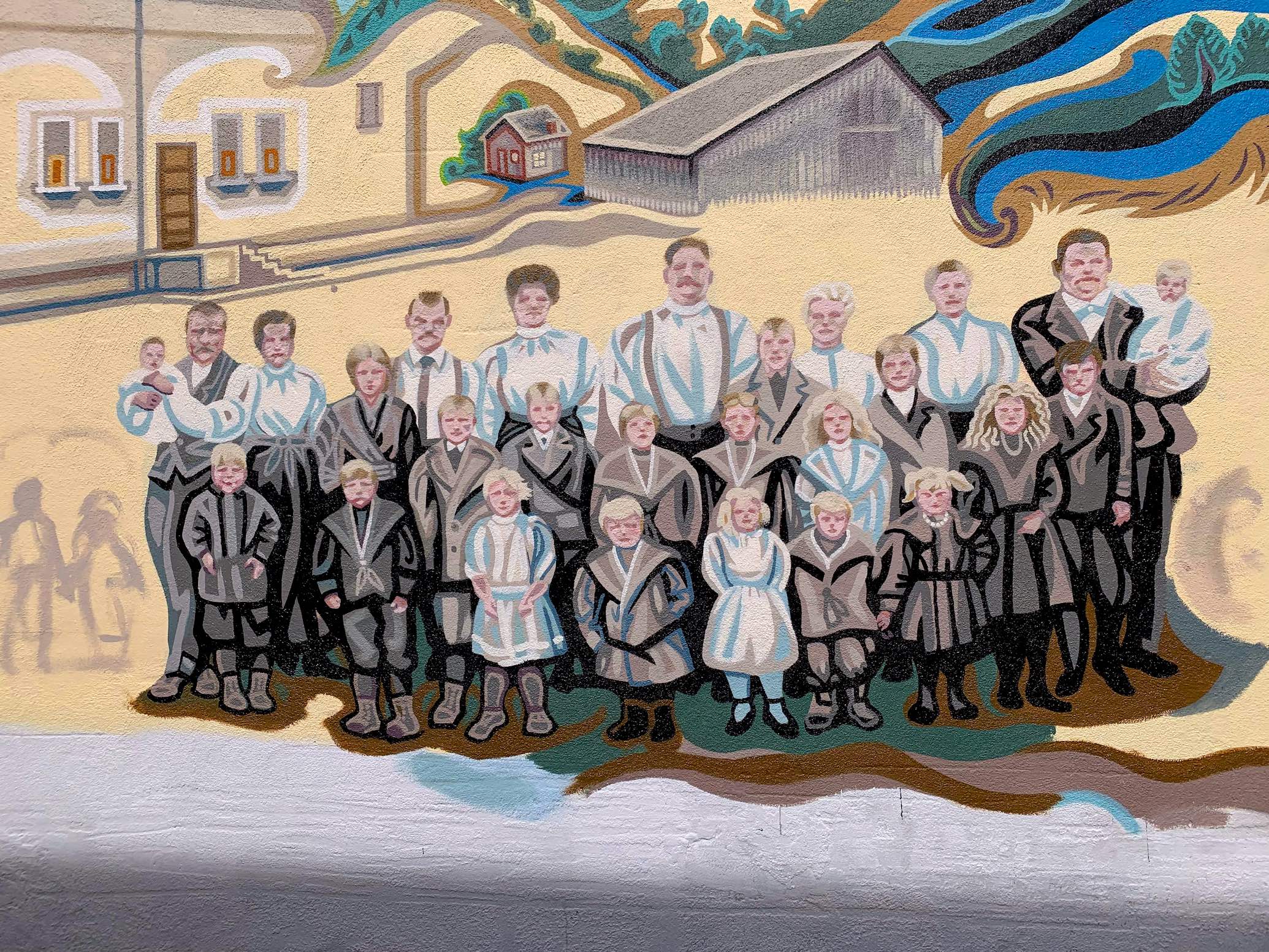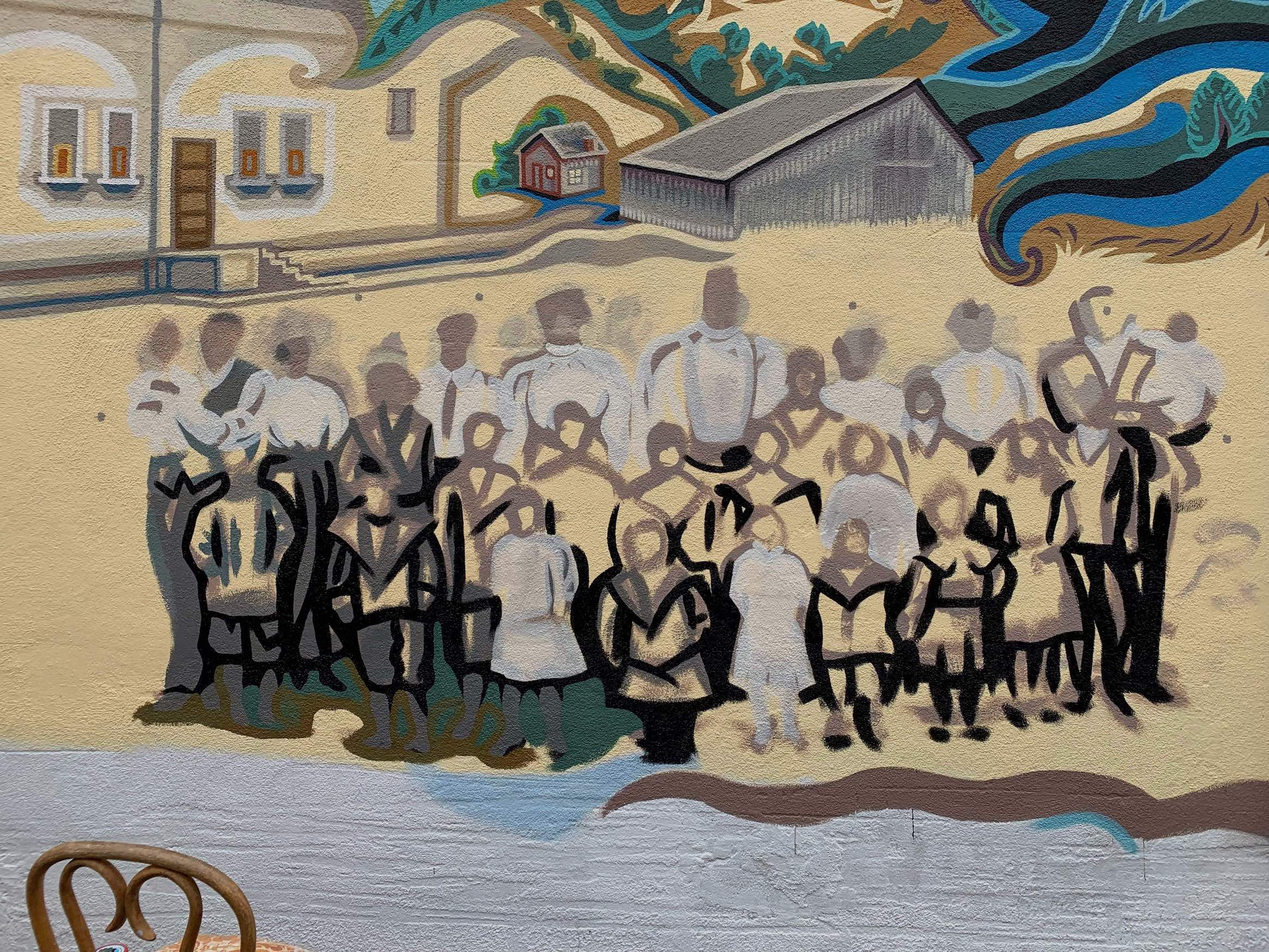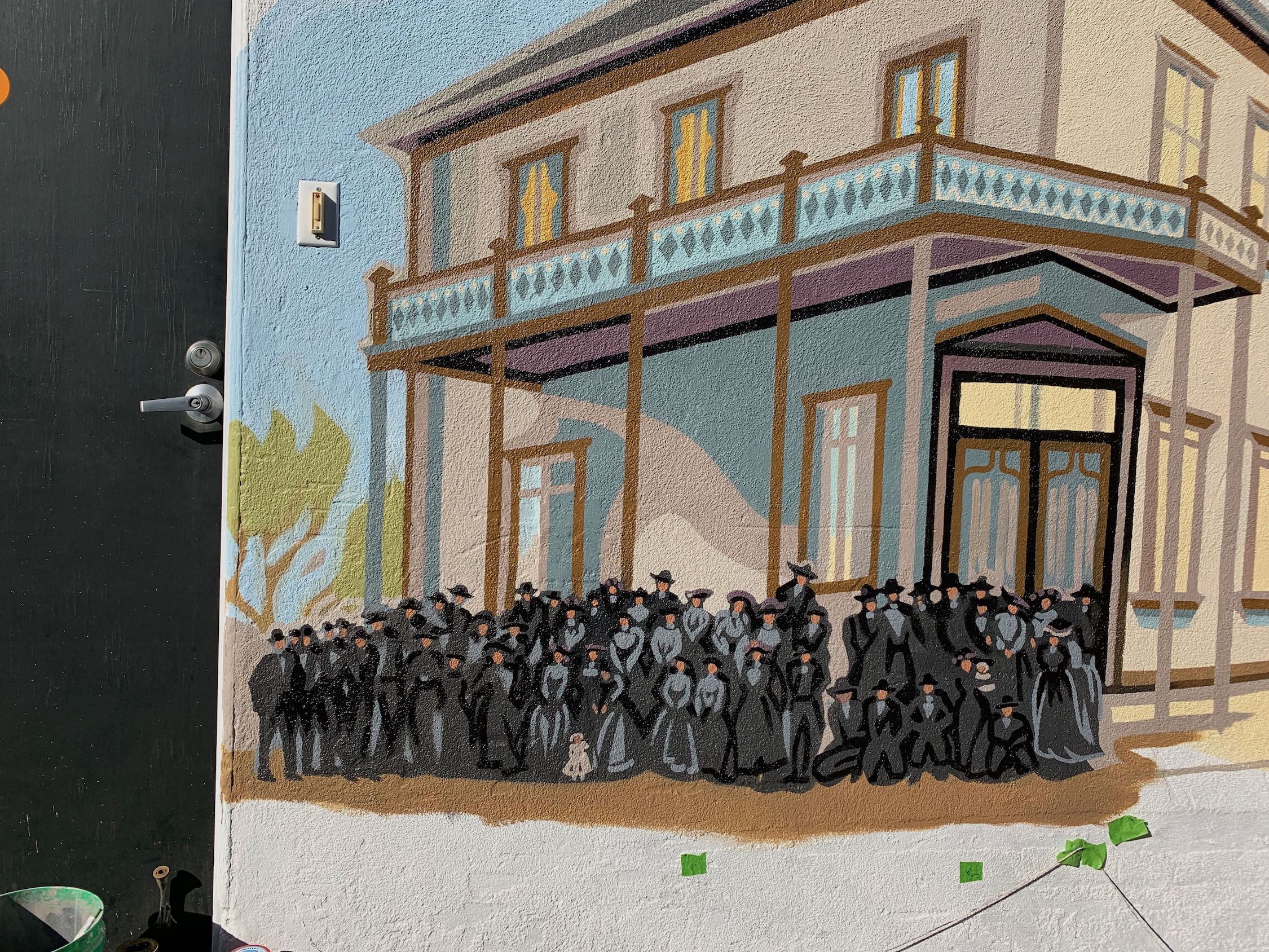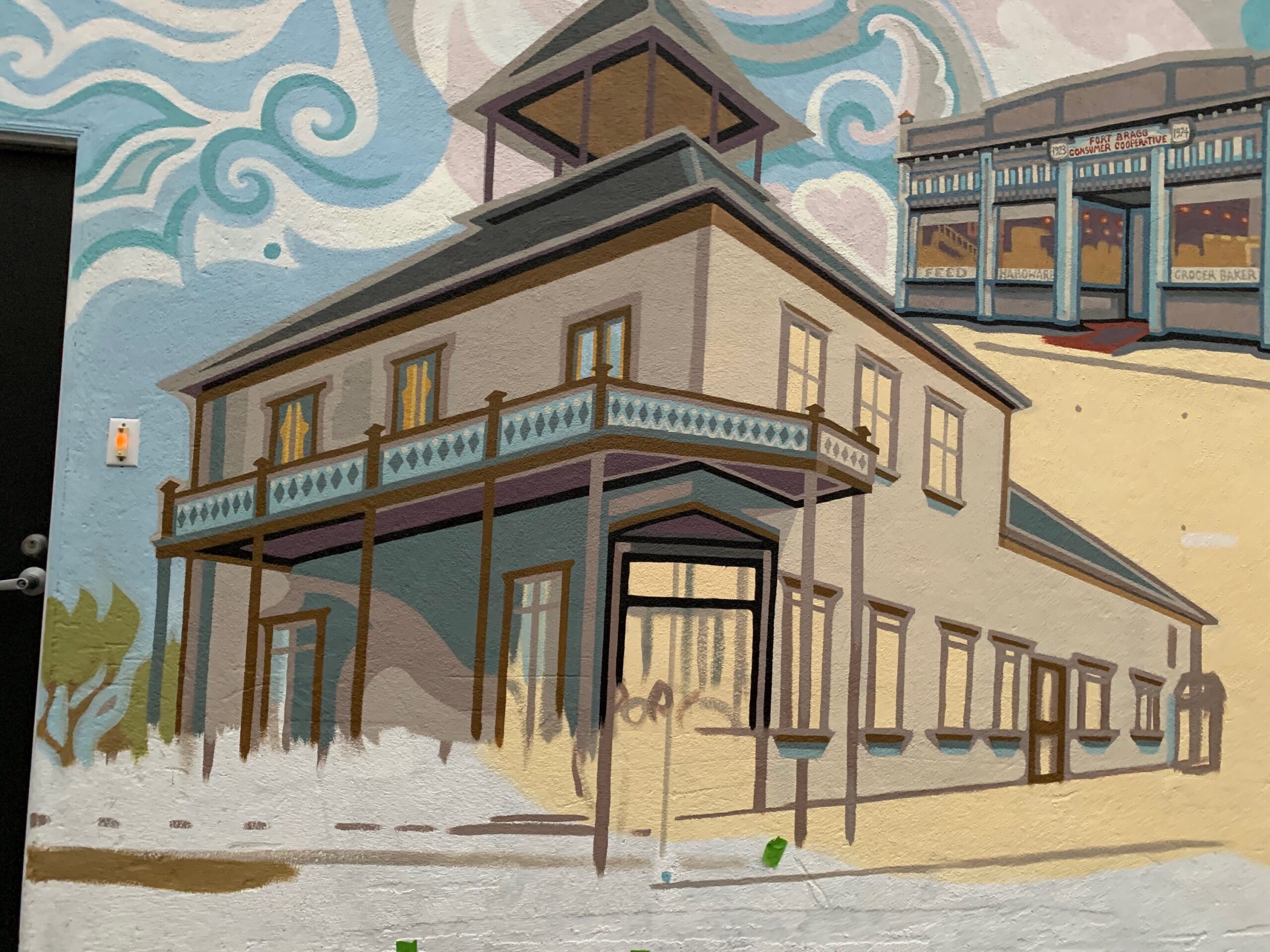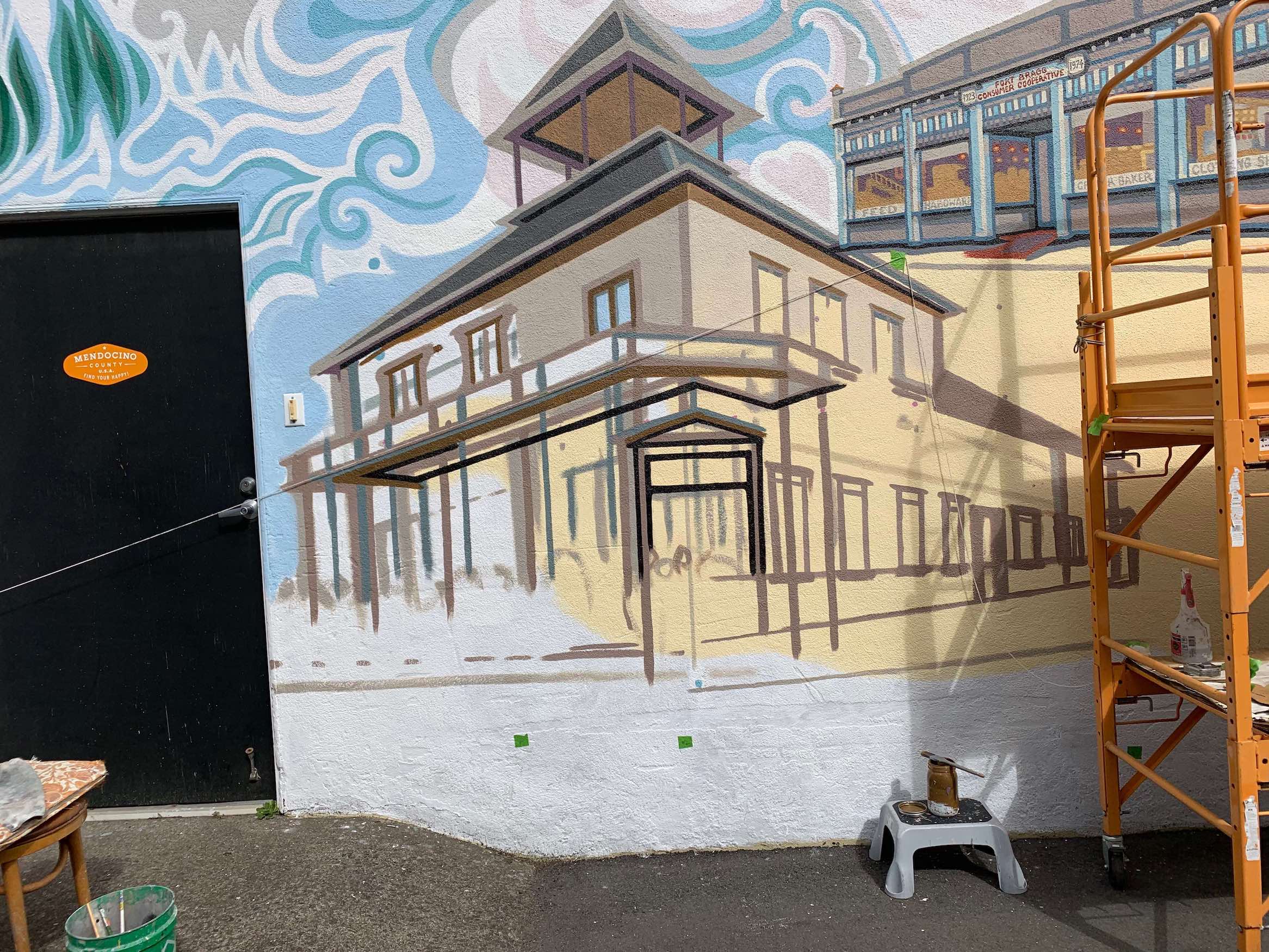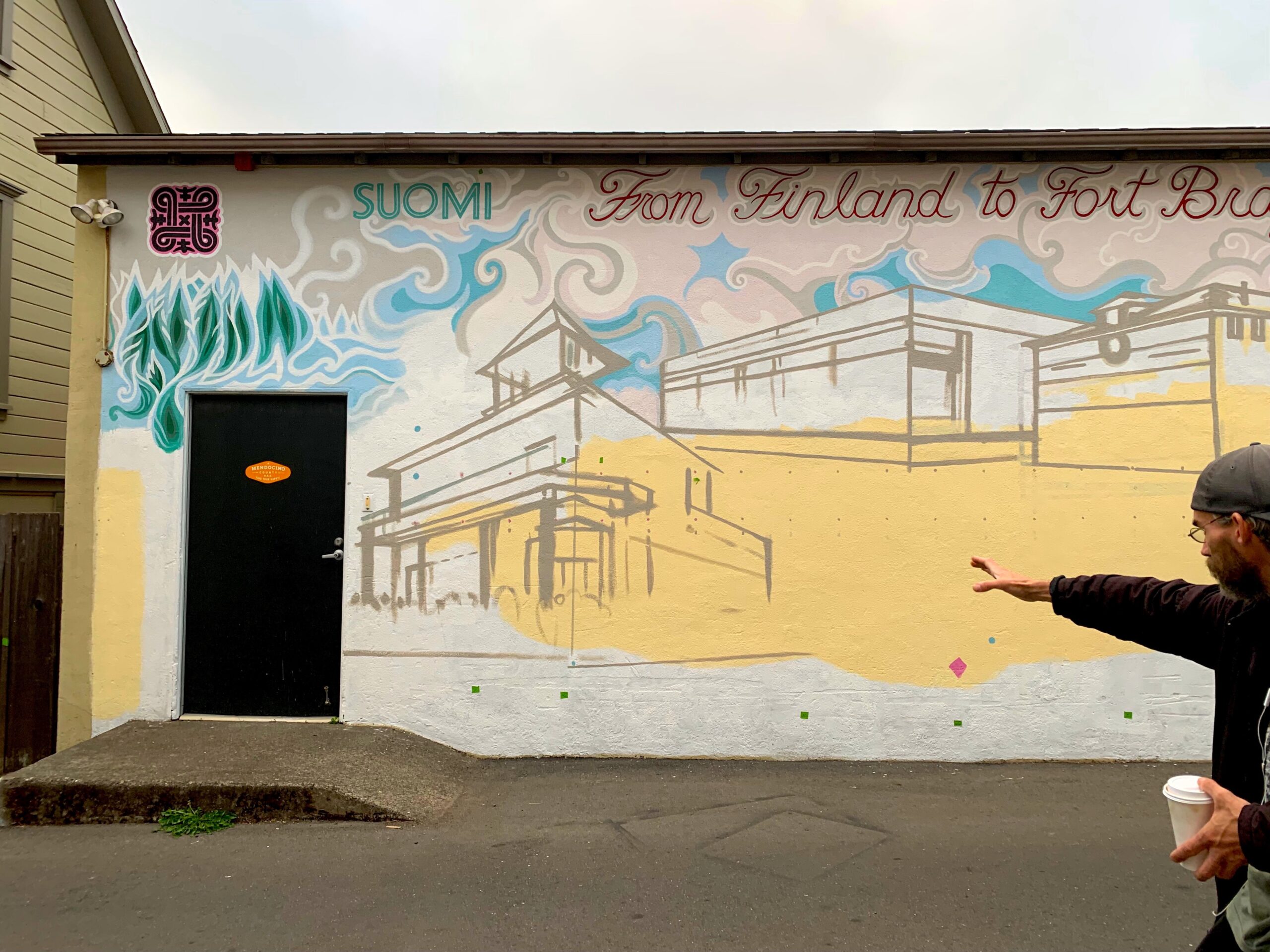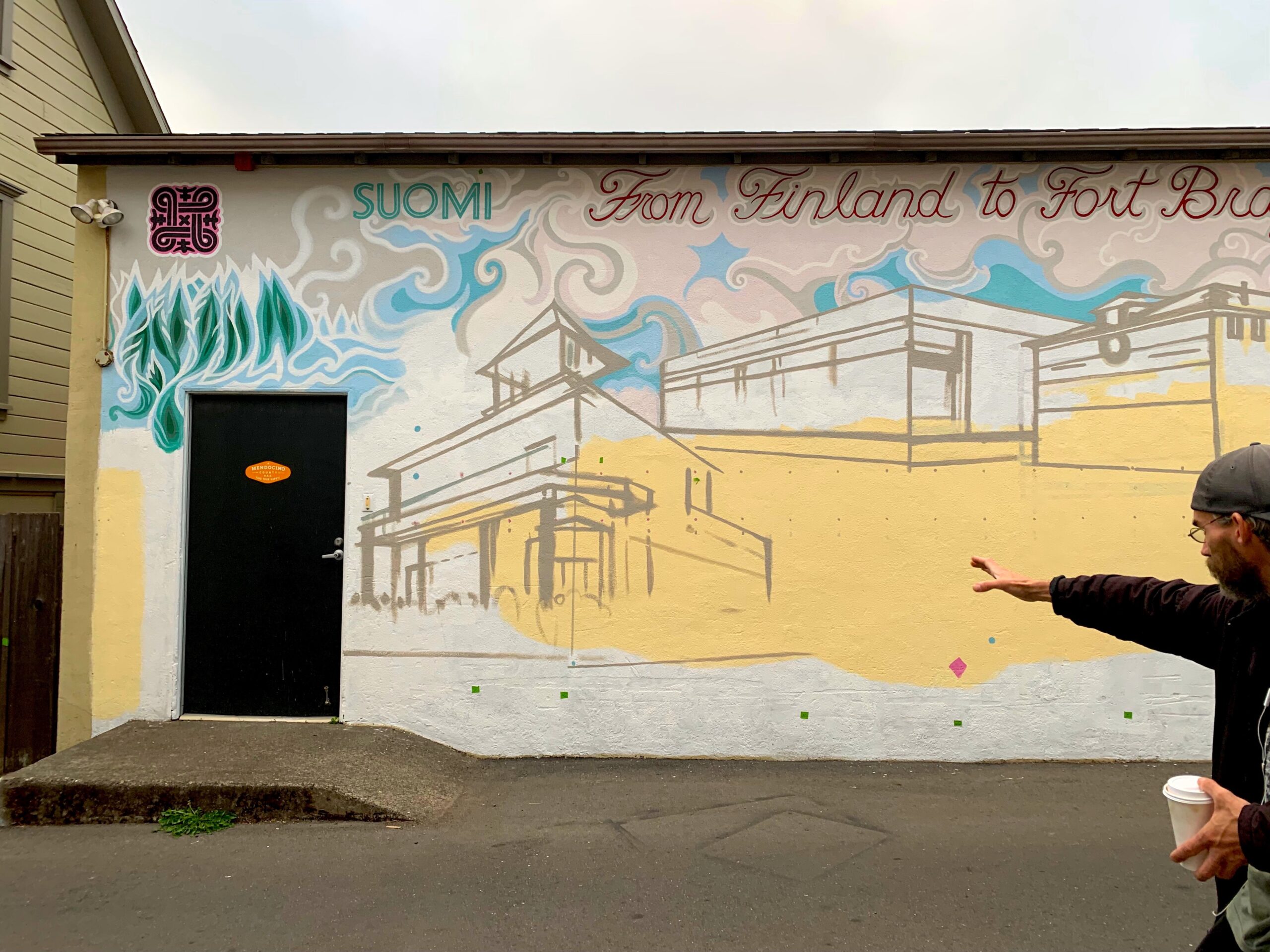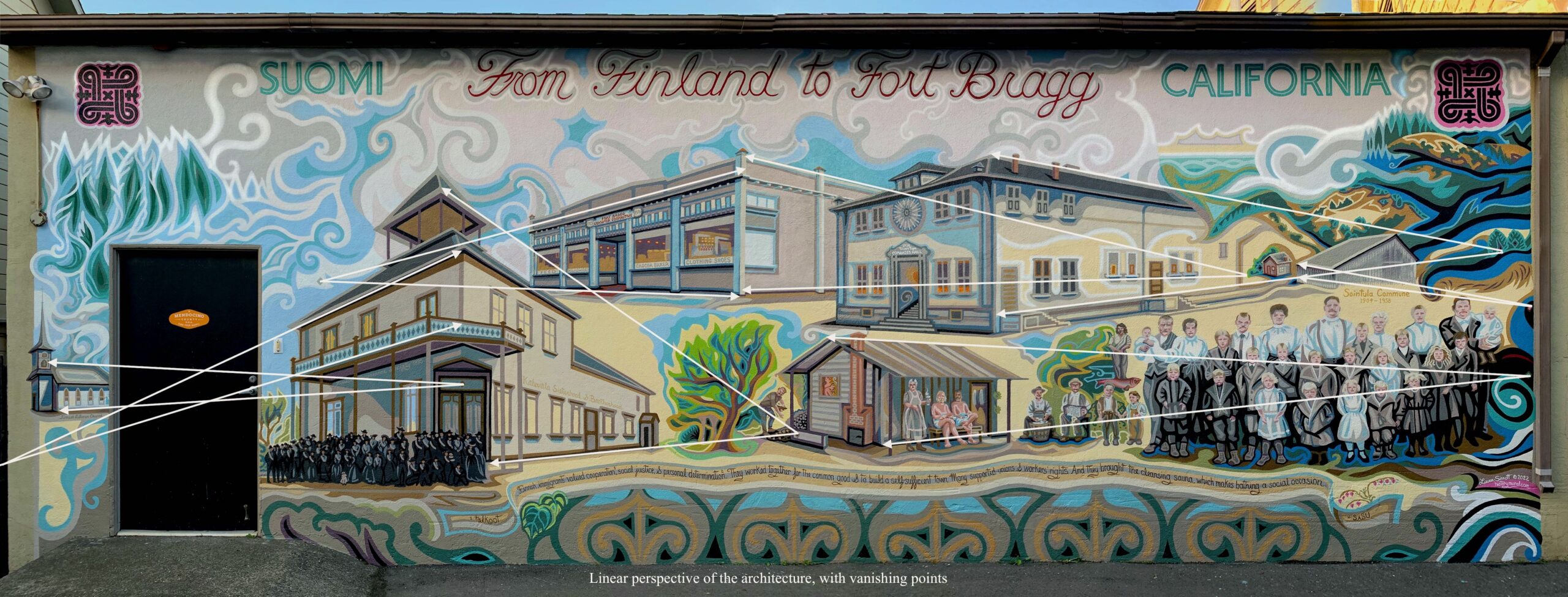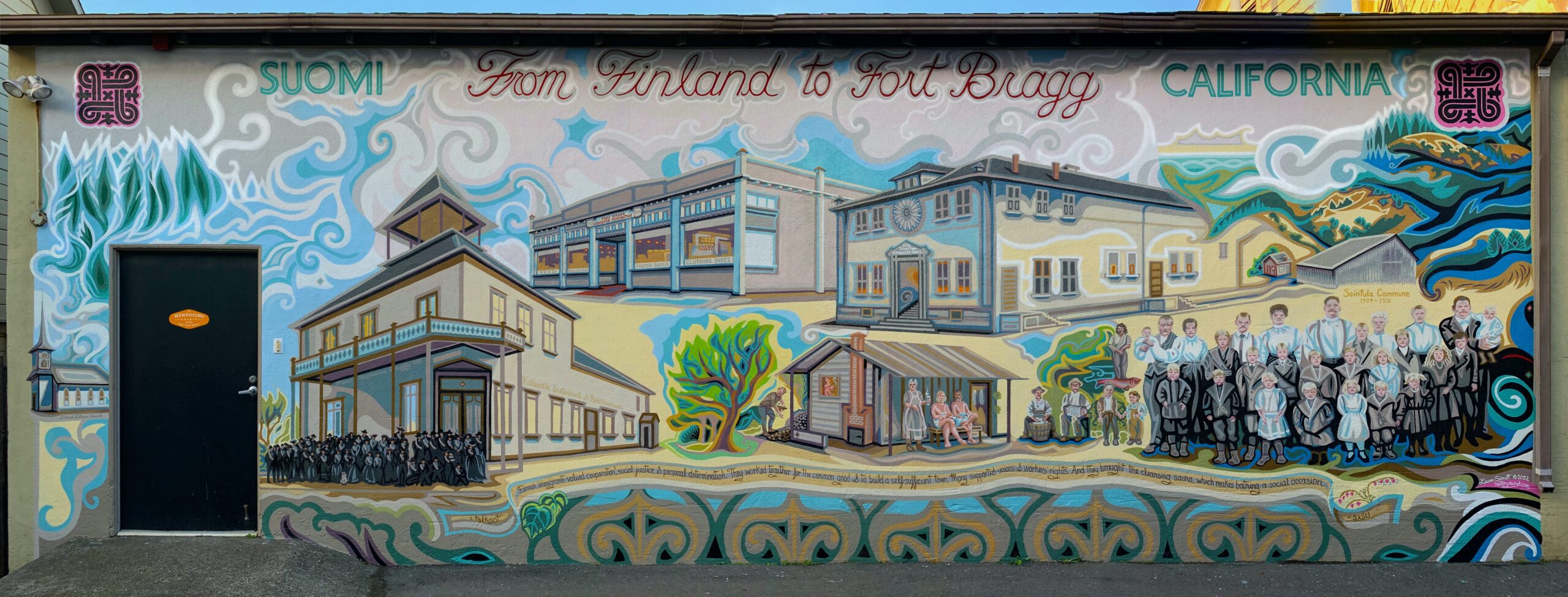
Title
From Finland to Fort Bragg
Artist: Lauren Sinnott
The new history mural by Lauren Sinnott illustrates the rich heritage of the many Finnish immigrants to this coastal northern California town.
The mural contains portraits of real people, past and present, and images of the functional and often beautiful structures built by the Finnish families to house their activities and make it easy to get work done and have fun.
For example, the Finns built a huge hall (7,500 sq. ft.) in order to put on concerts, throw parties, present lectures and stage plays. Its name was Toveri Tupa, or Comrades’ Hall. But tupa translates as “cottage” so it meant something more like the Comrades’ cozy living room. After all, nobody had an actual living room that could receive several hundred guests.
The Finns were the biggest immigrant group coming to and creating Fort Bragg. There was a large “Finn Town” in the eastern part of the city, as well as settlements on Pudding Creek, Tunnel Hill, and Noyo Hill. Also in Comptche, a bit farther away. These communities built their own halls and schools, often reached by crossing a walking bridge suspended over rivers.
To see more you can visit Lauren’s website that has this and her other incredible history murals!
Immigrants from Finland during the late 1800s and early 1900s formed the largest national group to create the bustling town of Fort Bragg on the northern California coast. The Finns valued cooperation, equality, and a state of mind called sisu, meaning personal determination in the face of adversity. They worked together for the common good and brought the cleansing sauna, which turns bathing into a party!The new history mural by Lauren Sinnott illustrates this rich heritage. Located downtown, it was sponsored by the City of Fort Bragg and local dentist/art patron Alan Limbird.
Lauren found her true calling as she painted the block-long narrative history mural in Ukiah: telling the story of a place through a tapestry of real events and portraits of local people.
Lauren Sinnott is an artist, historian, seamstress and former Mayor. Her route to this part of California where populations are dwarfed by the ridged landscape and pounding ocean, led first through Europe and Texas. Lauren was raised in Wisconsin’s dairyland by a working artist mother and poet father. She spent her senior year as an AFS exchange student in Belgium, speaking only French and discovering the art of conversation, four-hundred year old houses, good coffee and great beer. At Rice University in happily hot Houston, she earned a BA in Art and French, a BFA in painting, and an MA in Art History.
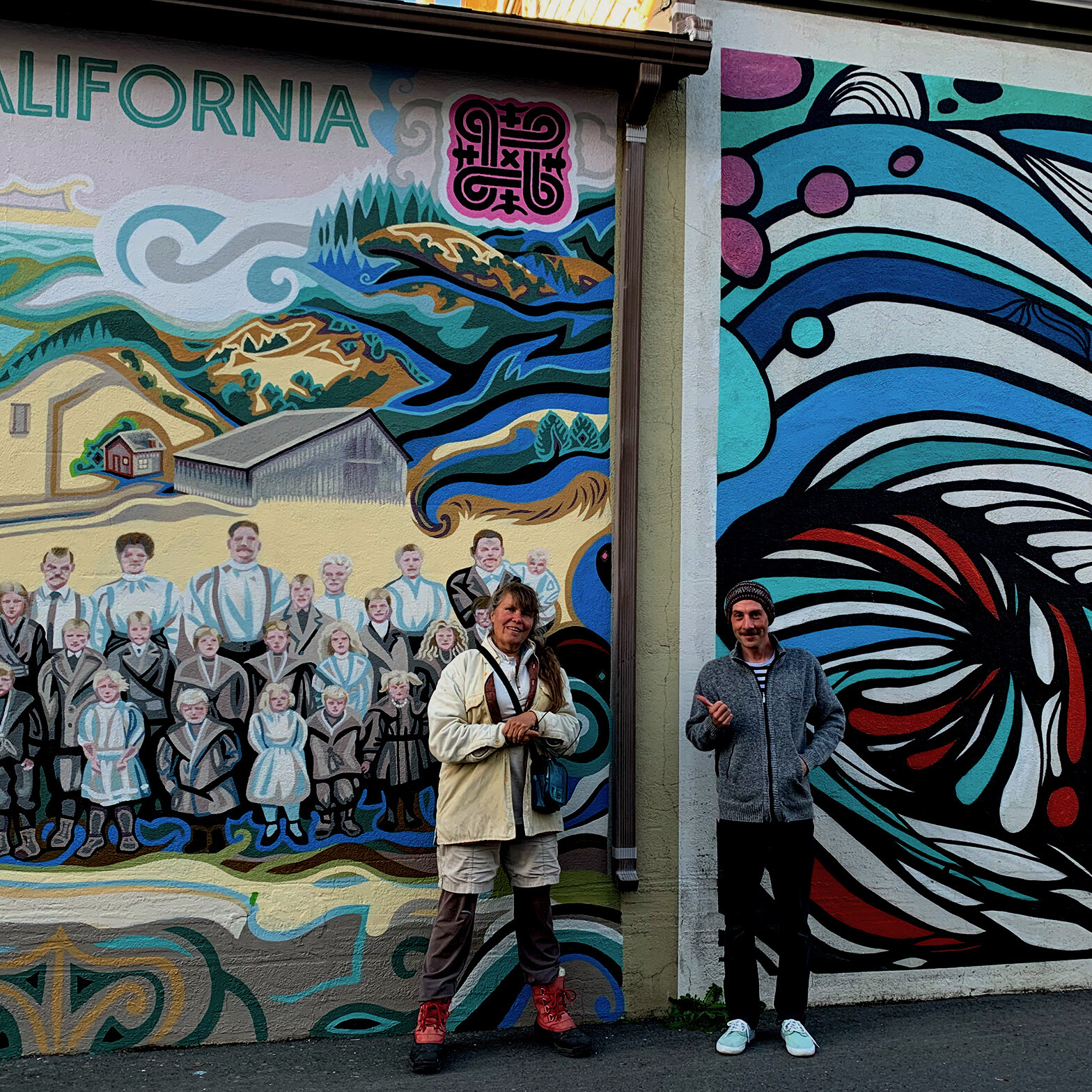
In 1999 Lauren and her two young sons left city life, heading west in a school bus outfitted with beds and a wood stove. They lived in the bus on a south coast ridge for a year. After moving into Point Arena, Lauren paid her new mortgage with jobs ranging from business signs to ornate murals, from tombstone design to painting a high school mascot on the basketball court floor. She sewed a life-size torso with female reproductive parts for a doctor and created the Velvet Vulva line of purses for feminists, therapists and brides. She painted curbs and hemmed pants. Her career crown jewel is the huge historical narrative mural on the north wall of the Ukiah Valley Conference Center. It is a public work for everyone and about everyone. The mural contains over two-hundred portraits, and tells many stories past and present. Lauren’s style combines realism with decorative pattern, portraiture with symbolism and inscription, subtle color with giant curlicues!
Lauren’s new mural is called “From Finland to Fort Bragg” and continues her love of detailed historical illustration as a way to honor the subject and keep memory alive.See much more at www.historymural.comSee Lauren’s job site updates on Facebook https://www.
When your studio/living room is a downtown sidewalk, you meet people and hear about their lives. They bring you scones and sushi. You paint and ask questions and listen. The planned subject matter for an ambitious depiction of history starting before human habitation and marching into the future grows even bigger and very much better. The project is now a collaboration, not of brushwork, but of content. To all this, Lauren brings her life-drawing skill, knowledge of art history, symbolism and delight in pattern. Alan Limbird saw the Ukiah mural in progress and said, “Come do your next one in Fort Bragg! I have just the building.”
Contemplating what part of Fort Bragg history to paint, Lauren sought something inspirational and neglected. What was an important story that deserved a new spotlight? She read a mention of the early Consumer Co-operative being founded by immigrants from Finland. Further research revealed how many Finnish immigrants had come here, bringing strong traditions of equality and cooperation in the service of building a self-sufficient community. The mural concept started to take shape!.
- IMAGE 10 of the wall from the left, in progress
- IMAGE 11 Toveri Tupa MASTER
- IMAGE 12 Toveri Tupa front
- IMAGE 13 Temperance Society/Kalevala Hall in the mural
- IMAGE 14 Photo of Temperance Society in front of their hall
- IMAGE 15 David Maki showing the Fort Bragg Kalevala Brotherhood charter of 1897
- IMAGE 16 Kalevala Hall – closer detail
The Finnish Kalevala lodges were formed to enhance community cohesion and prosperity and to keep Finnish culture alive. The Kalevala Brotherhood and Sisterhood were chartered in Fort Bragg in 1897 and 1898. They bought the hall in 1920.
The Fort Bragg Cooperative store started in 1923.
- IMAGE 17 Consumer Co-op in the mural
- IMAGE 18 photo of the Co-op c. 1940
- IMAGE 19 detail of the Co-op in the mural
There was a wave of cooperatives being established around 1900 across California and the nation. Associations of co-ops formed to gain strength in numbers. But excessively rapid growth led much of the network to crumble, and most co-ops were closed during the 1920s. By the time the US economy crashed in 1929, there were only 5 co-ops left in California, and Fort Bragg’s was one of them!
The Finnish Evangelical Lutheran Church was constructed by Finnish immigrants in 1889 at the corner of Redwood Avenue and Corry Street.
- IMAGE 20 Lutheran Church
The beloved church was a central part of the Finnish community. Many of the immigrants also welcomed the fact that becoming a member of a church was a choice. They welcomed the American principle of freedom of religion, including the freedom to join no church at all.
See www.historymural.com/finn/
- IMAGE 21 top title
Narrative murals can benefit from symbols and writing. Both are present here. I wrote the mural’s title at the top, using skills I learned in grade school, and painted the Finnish hannunvaakuna, symbol of good fortune, in the top corners.
- IMAGE 22 need this
- IMAGE 23 need this
- IMAGE 24 inscription detail
“Finnish immigrants valued cooperation (footnote 1), social justice, & personal determination (footnote 2). They worked together for the common good & to build a self-sufficient town. Many supported unions and workers’ rights. And they brought the cleansing sauna, which makes bathing a social occasion.” 1. talkoot means work done as a group for the common good. 2. sisu is the very widely understood Finnish trait of calm determination in the face of adversity.
- IMAGE 25 mural detail of the sauna
Saturday evening saunas were a chance to relax, talk, invite guests, and enjoy coffee and cake, or beer and sausage afterwards.
Grandmas did a lot of things, including catch salmon and serve coffee
In the mural, the lady serving coffee is Finnish descendant VoVo Cain’s beloved Grandma Katie. She was Katie Halonen before the name was “Americanized” to Hellen.
- IMAGE 26 Grandma Katie
- IMAGE 27 closer view of the sauna figures
- IMAGE 28 Lauri Rissanen posing
- IMAGE 29 detail of Hilma Holmi Maki
- PHOTO 30 of David Maki’s grandma Hilma Holmi Maki with her fish
- IMAGE 31 Sointula group
- IMAGE 32 mural central group
- PHOTO 33 David Maki looking at his grandma’s portrait
- PHOTO 34 Sylvia Erickson Bartley looking at her portrait
- PHOTO 35 Paul Nylund with his portrait
See more here www.historymural.com/
- IMAGE 36 Lauren working on scaffolding
- IMAGE 37 Linear perspective!
- IMAGE 38 left side w/string for achieving the linear perspective diagonals
- IMAGE 39 buildings take shape, Adam points at the wall
- IMAGE 40 perspective of the architecture
- IMAGE 41 the building is almost complete, now for the figures…
- IMAGE 42 the people are complete.
- IMAGE 43 Sointula figures
- IMAGE 44 Sointula portraits complete
- IMAGE 45 whole wall
The tree takes shape:
- IMAGE 46 tree sketch
- IMAGE 47 tree finished
- IMAGE 48 the mural seen from the right.
- IMAGE 49 the two murals meet


